LG Electronics USA L58VL Multi-band CDMA/LTE Phone with Bluetooth and WLAN User Manual
LG Electronics MobileComm USA, Inc. Multi-band CDMA/LTE Phone with Bluetooth and WLAN Users Manual
Users Manual
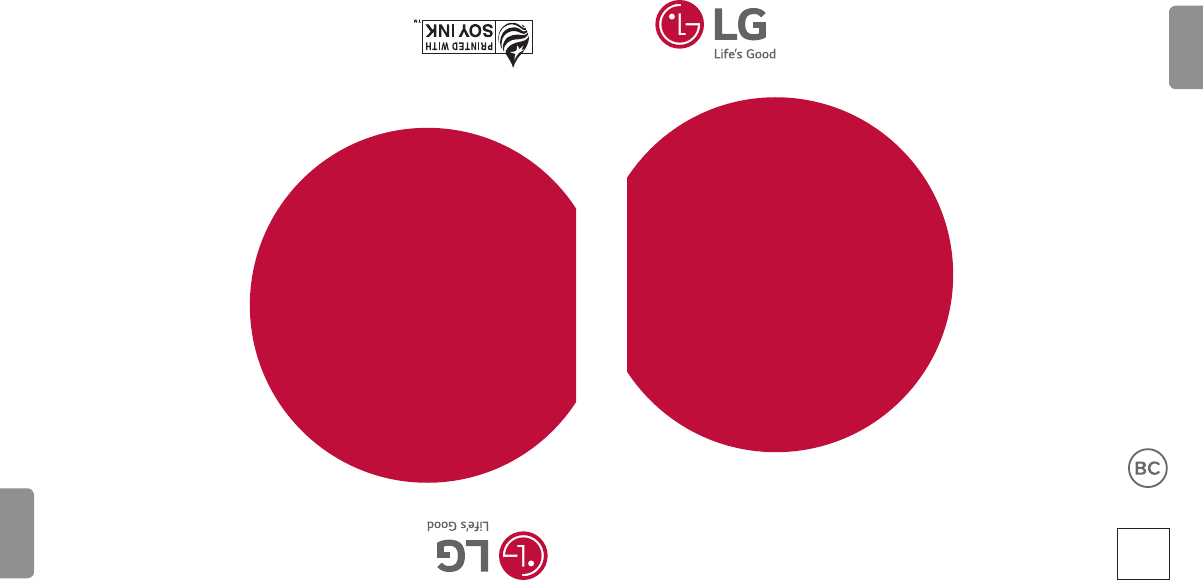
Printed in China
www.lg.com
XXXXXXXXXX (1.0)
www.lg.com
ENGLISH
ESPAÑOL
USEr GUIdE
GUíA dEL USUArIO
LG L58VL
LG L58VL
About this user guide
Thank you for choosing LG. Please carefully read this user guide before
using the device for the first time to ensure safe and proper use.
• Always use genuine LG accessories. The supplied items are designed only for this
device and may not be compatible with other devices.
• This device is not suitable for people who have a visual impairment due to the
touchscreen keyboard.
• Descriptions are based on the device default settings.
• Default apps on the device are subject to updates and support for these apps
may be withdrawn without prior notice. If you have any questions about an app
provided with the device, please contact a LG Service center. For user-installed
apps, please contact the relevant service provider.
• Modifying the device’s operating system or installing software from unofficial
sources may damage the device and lead to data corruption or data loss. Such
actions will violate your LG licence agreement and void your warranty.
• Some contents and illustrations may differ from your device depending on the
region, service provider, software version, or OS version, and are subject to
change without prior notice.
• Software, audio, wallpaper, images, and other media supplied with your
device are licensed for limited use. If you extract and use these materials for
commercial or other purposes, you may be infringing copyright laws. As a user,
you are fully are entirely responsible for the illegal use of media.
• Additional charges may apply for data services, such as messaging, uploading,
downloading, auto-syncing and location services. To avoid additional charges,
select a data plan suitable to your needs. Contact your service provider to obtain
additional details.
ENGLISH

2
Instructional notices
WARNING Situations that could cause injury to yourself or others, or
damage to the device or other property.
NOTE Notices or additional information.
3
LIMITED WARRANTY STATEMENT
ARBITRATION NOTICE: THIS LIMITED WARRANTY CONTAINS AN
ARBITRATION PROVISION THAT REQUIRES YOU AND LG TO RESOLVE
DISPUTES BY BINDING ARBITRATION INSTEAD OF IN COURT, UNLESS
YOU CHOOSE TO OPT OUT. IN ARBITRATION, CLASS ACTIONS AND
JURY TRIALS ARE NOT PERMITTED. PLEASE SEE THE SECTION TITLED
“PROCEDURE FOR RESOLVING DISPUTES” BELOW.
Warranty Laws
The following laws govern warranties that arise in retail sales of consumer
goods:
• The California Song-Beverly Consumer Warranty Act [CC §§1790 et
seq],
• The California Uniform Commercial Code, Division Two [Com C §§2101
et seq], and
• The federal Magnuson-Moss Warranty Federal Trade Commission
Improvement Act [15 USC §§2301 et seq; 16 CFR Parts 701– 703].
A typical Magnuson-Moss Act warranty is a written promise that the
product is free of defects or a written promise to refund, repair, or
replace defective goods. [See 15 USC §2301(6).] Remedies include
damages for failing to honor a written warranty or service contract or
for violating disclosure provisions. [See 15 USC §2310(d).] Except for
some labeling and disclosure requirements, the federal Act does not
preempt state law. [See 15 USC §2311.]
4
1. WHAT THIS WARRANTY COVERS:
LG offers you a limited warranty that the enclosed subscriber unit and its
enclosed accessories will be free from defects in material and workmanship,
according to the following terms and conditions:
(1) The limited warranty for the product extends for TWELVE (12)
MONTHS beginning on the date of purchase of the product with
valid proof of purchase, or absent valid proof of purchase, FIFTEEN
(15) MONTHS from date of manufacture as determined by the unit's
manufacture date code.
(2) The limited warranty extends only to the original purchaser of the
product and is not assignable or transferable to any subsequent
purchaser/end user.
(3) This warranty is good only to the original purchaser of the product
during the warranty period as long as it is in the U.S., including Alaska,
Hawaii, U.S. Territories and Canada.
(4) The external housing and cosmetic parts shall be free of defects at
the time of shipment and, therefore, shall not be covered under these
limited warranty terms.
(5) Upon request from LG, the consumer must provide information to
reasonably prove the date of purchase.
(6) The customer shall bear the cost of shipping the product to the
Customer Service Department of LG. LG shall bear the cost of shipping
the product back to the consumer after the completion of service under
this limited warranty.
5
2. WHAT THIS WARRANTY DOES NOT COVER:
(1) Defects or damages resulting from use of the product in other than its
normal and customary manner.
(2) Defects or damages from abnormal use, abnormal conditions, improper
storage, exposure to moisture or dampness, unauthorized modifications,
unauthorized connections, unauthorized repair, misuse, neglect, abuse,
accident, alteration, improper installation, or other acts which are not
the fault of LG, including damage caused by shipping, blown fuses, spills
of food or liquid.
(3) Breakage or damage to antennas unless caused directly by defects in
material or workmanship.
(4) That the Customer Service Department at LG was not notified by
consumer of the alleged defect or malfunction of the product during
the applicable limited warranty period.
(5) Products which have had the serial number removed or made illegible.
(6) This limited warranty is in lieu of all other warranties, express or implied
either in fact or by operations of law, statutory or otherwise, including,
but not limited to any implied warranty of marketability or fitness for a
particular use.
(7) Damage resulting from use of non LG approved accessories.
(8) All plastic surfaces and all other externally exposed parts that are
scratched or damaged due to normal customer use.
(9) Products operated outside published maximum ratings.
(10) Products used or obtained in a rental program.
(11) Consumables (such as fuses).
6
3. WHAT LG WILL DO:
LG will, at its sole option, either repair, replace or refund the purchase price
of any unit that is covered under this limited warranty. LG may choose at
its option to use functionally equivalent re-conditioned, refurbished or new
units or parts or any units. In addition, LG will not re-install or back-up
any data, applications or software that you have added to your phone. It
is therefore recommended that you back-up any such data or information
prior to sending the unit to LG to avoid the permanent loss of such
information.
4. STATE LAW RIGHTS:
No other express warranty is applicable to this product. THE DURATION
OF ANY IMPLIED WARRANTIES, INCLUDING THE IMPLIED WARRANTY OF
MARKETABILITY OR MERCHANTABILITY OR FITNESS FOR A PARTICULAR
PURPOSE, IS LIMITED TO THE DURATION OF THE EXPRESS WARRANTY
HEREIN. LG SHALL NOT BE LIABLE FOR THE LOSS OF THE USE OF THE
PRODUCT, INCONVENIENCE, LOSS OR ANY OTHER DAMAGES, DIRECT OR
CONSEQUENTIAL, ARISING OUT OF THE USE OF, OR INABILITY TO USE,
THIS PRODUCT OR FOR ANY BREACH OF ANY EXPRESS OR IMPLIED
WARRANTY, INCLUDING THE IMPLIED WARRANTY OF MARKETABILITY
OR MERCHANTABILITY OR FITNESS FOR A PARTICULAR PURPOSE
APPLICABLE TO THIS PRODUCT.
Some states do not allow the exclusive limitation of incidental or
consequential damages or limitations on how long an implied warranty
lasts; so these limitations or exclusions may not apply to you. This warranty

7
gives you specific legal rights and you may also have other rights which
vary from state to state.
5. HOW TO GET WARRANTY SERVICE:
To obtain warranty service, please call or fax to the following telephone
numbers from anywhere in the continental United States:
Tel. 1-800-793-8896 or Fax. 1-800-448-4026
Or visit http://www.lg.com/us/support. Correspondence may also be mailed
to:
LG Electronics Service- Mobile Handsets, P.O. Box 240007, Huntsville, AL
35824
DO NOT RETURN YOUR PRODUCT TO THE ABOVE ADDRESS. Please
call or write for the location of the LG authorized service center nearest
you and for the procedures for obtaining warranty claims.
PROCEDURE FOR RESOLVING DISPUTES:
ALL DISPUTES BETWEEN YOU AND LG ARISING OUT OF OR RELATING
IN ANY WAY TO THIS LIMITED WARRANTY OR THE PRODUCT SHALL BE
RESOLVED EXCLUSIVELY THROUGH BINDING ARBITRATION, AND NOT
IN A COURT OF GENERAL JURISDICTION. BINDING ARBITRATION MEANS
THAT YOU AND LG ARE EACH WAIVING THE RIGHT TO A JURY TRIAL
AND TO BRING OR PARTICIPATE IN A CLASS ACTION.
Definitions. For the purposes of this section, references to “LG” mean LG
Electronics MobileComm U.S.A., Inc., its parents, subsidiaries and affiliates,
and each of their officers, directors, employees, agents, beneficiaries,
predecessors in interest, successors, assigns and suppliers; references to

8
“dispute” or “claim” shall include any dispute, claim or controversy of any
kind whatsoever (whether based in contract, tort, statute, regulation,
ordinance, fraud, misrepresentation or any other legal or equitable theory)
arising out of or relating in any way to the sale, condition or performance of
the product or this Limited Warranty.
Agreement to Binding Arbitration and Class Action Waiver. You and LG
agree to resolve any claims between us only by binding arbitration on an
individual basis, unless you opt out as provided below. Any dispute between
you and LG shall not be combined or consolidated with a dispute involving
any other person’s or entity’s product or claim. More specifically, without
limitation of the foregoing, any dispute between you and LG shall not under
any circumstances proceed as part of a class or representative action.
Instead of arbitration, either party may bring an individual action in small
claims court, but that small claims court action may not be brought on a
class or representative basis.
Arbitration Rules and Procedures. To begin arbitration of a claim, either you
or LG must make a written demand for arbitration. The arbitration will be
administered by the American Arbitration Association (AAA) and will be
conducted before a single arbitrator under the AAA’s Consumer Arbitration
Rules that are in effect at the time the arbitration is initiated (referred to
as the “AAA Rules”) and under the procedures set forth in this section. The
AAA Rules are available online at
www.adr.org/consumer. Send a copy of your written demand for arbitration,
as well as a copy of this provision, to the AAA in the manner described
in the AAA Rules. You must also send a copy of your written demand to

9
LG at LG Electronics, USA, Inc.Attn: Legal Department-Arbitration1000
Sylvan AvenueEnglewood Cliffs, NJ 07632. If there is a conflict between
the AAA Rules and the rules set forth in this section, the rules set forth in
this section will govern. This arbitration provision is governed by the Federal
Arbitration Act. Judgment may be entered on the arbitrator’s award in any
court of competent jurisdiction. All issues are for the arbitrator to decide,
except that issues relating to the scope and enforceability of the arbitration
provision and to the arbitrability of the dispute are for the court to decide.
The arbitrator is bound by the terms of this provision.
Governing Law: The law of the state of your residence shall govern this
Limited Warranty and any disputes between us except to the extent that
such law is preempted by or inconsistent with applicable federal law.
Fees/Costs. You do not need to pay any fee to begin an arbitration. Upon
receipt of your written demand for arbitration, LG will promptly pay all
arbitration filing fees to the AAA unless you seek more than $25,000 in
damages, in which case the payment of these fees will be governed by the
AAA Rules. Except as otherwise provided for herein, LG will pay all AAA
filing, administration and arbitrator fees for any arbitration initiated in
accordance with the AAA Rules and this arbitration provision. If you prevail
in the arbitration, LG will pay your reasonable attorneys’ fees and expenses
to the extent required by applicable law. If the arbitrator finds either the
substance of your claim or the relief sought in the demand is frivolous or
brought for an improper purpose (as measured by the standards set forth
in Federal Rule of Civil Procedure 11(b)), then the payment of all arbitration
fees will be governed by the AAA Rules. In such a situation, you agree to

10
reimburse LG for all monies previously disbursed by it that are otherwise
your obligation to pay under the AAA Rules. Except as otherwise provided
for, LG waives any rights it may have to seek attorneys’ fees and expenses
from you if LG prevails in the arbitration.
Hearings and Location. If your claim is for $25,000 or less, you may choose
to have the arbitration conducted solely on the basis of (1) documents
submitted to the arbitrator, (2) through a telephonic hearing, or (3) by an
in-person hearing as established by the AAA Rules. If your claim exceeds
$25,000, the right to a hearing will be determined by the AAA Rules. Any
in-person arbitration hearings will be held at a location within the federal
judicial district in which you reside unless we both agree to another location
or we agree to a telephonic arbitration.
Opt Out. You may opt out of this dispute resolution procedure. If you opt
out, neither you nor LG can require the other to participate in an arbitration
proceeding. To opt out, you must send notice to LG no later than 30
calendar days from the date of the first consumer purchaser’s purchase of
the product by either: (i) sending an e-mail to optout@lge.com, with the
subject line: “Arbitration Opt Out” or (ii) calling 1-800-980-2973.You must
include in the opt out e-mail or provide by telephone: (a) your name and
address; (b) the date on which the product was purchased; (c) the product
model name or model number; and (d) the IMEI or MEID or Serial Number,
as applicable (the IMEI or MEID or Serial Number can be found (i) on the
product box; (ii) on a label on the back of the product beneath the battery,
if the battery is removable; or (iii) from the settings menu via the following
path: Settings About phone Status). You may only opt out of the
11
dispute resolution procedure in the manner described above (that is, by
e-mail or telephone); no other form of notice will be effective to opt out
of this dispute resolution procedure. Opting out of this dispute resolution
procedure will not affect the coverage of the Limited Warranty in any way,
and you will continue to enjoy the full benefits of the Limited Warranty. If
you keep this product and do not opt out, then you accept all terms and
conditions of the arbitration provision described above.
12
Features you will love ................. 16
Capture+ ..................................................17
Using Capture+ ............................................................17
Viewing the saved memo .......................................18
KnockON ..................................................19
Turning the screen on ...............................................19
Turning the screen off ..............................................19
Knock Code ..............................................20
Setting up the Knock Code feature .................20
Unlocking the screen using the Knock Code 20
Basics .......................................... 21
Accessories ..............................................22
Device layout ............................................23
Turning Your Device On and Off ..............26
Installing the battery ...............................27
Charging the battery ...............................29
Inserting a memory card ..........................30
Removing the memory card .....................31
Touch screen tips .....................................32
Tap or touch ................................................................... 32
Touch and hold..............................................................33
Drag.....................................................................................33
Swipe or slide ................................................................ 34
Double-tap ...................................................................... 34
Pinch-to-Zoom .............................................................35
Google account setup ..............................36
Creating your Google account ............................36
Signing into your Google account.....................37
Locking and unlocking the device ............38
Changing the screen lock method....................38
Smart Lock......................................................................39
Home screen ............................................40
Getting to Know the Home Screen ................. 40
Returning to recently-used applications ......42
Customizing the Home screen ........................... 42
Using folders from the Home screen .............43
Noticationspanel .....................................................44
Capturing a screenshot ............................47
On-screen keyboard .................................47
Using the keypad and entering text ................47
Entering special characters...................................48
Transferring data between a PC and the
device .......................................................49
Transferring data using USB connection ...... 49
Table of contents
13
Apps ............................................ 50
Installing or uninstalling apps ..................51
To open the Play Store app ...................................51
To open a screen with details about an app 51
To uninstall applications ..........................................51
Calls .......................................................... 52
Making a call .................................................................. 52
Calling your contacts ................................................52
Answering and rejecting a call ............................53
Making a second call .................................................53
Viewing your call logs ...............................................53
Change your call settings ......................................54
Contacts ................................................... 55
Searching for a contact ........................................... 55
Adding a new contact .............................................. 55
Favorites contacts ......................................................55
Creating a group .......................................................... 56
Messaging ................................................57
Sending a message ....................................................57
Conversation view ......................................................58
Changing your messaging settings..................58
Camera .....................................................59
Taking a photo .............................................................. 59
Viewnderoptions .....................................................59
Interval shot ...................................................................60
Burst shot ........................................................................60
Gesture shot ..................................................................61
Multi-point Auto-focus ...........................................62
Once you have taken a photo ..............................62
Recording a video........................................................62
After recording a video ............................................63
Gallery ......................................................64
Viewing pictures .......................................................... 64
Editing photos ..............................................................64
Setting wallpaper ........................................................65
Zooming in and out ................................................... 65
Playing a video ..............................................................65
Deleting photos/videos ........................................... 67
Email ......................................................... 68
Adding an account ..................................................... 68
Working with account folders.............................68
Composing and sending email ............................68
Changing the Email app general settings .... 69
Deleting an email account ..................................... 69
Music ........................................................70
Playing a song ...............................................................70
Music player options .................................................71
Clock ......................................................... 73
Alarms ............................................................................... 73
World clock .....................................................................73
Timer...................................................................................74
Stopwatch .......................................................................74
14
Calculator ................................................. 75
Calendar ...................................................75
Voice Recorder .........................................76
Recording a sound or voice ...................................76
Downloads ................................................76
Google apps..............................................77
Settings ....................................... 79
Access the Settings menu ......................80
Wireless Networks ..................................81
Airplane mode ...............................................................81
Wi-Fi ...................................................................................81
Bluetooth .........................................................................82
Mobile data .....................................................................84
Call ....................................................................................... 84
Advanced Calling .........................................................84
Tethering .......................................................................... 85
Mobile networks ......................................................... 87
VPN ..................................................................................... 87
Emergency alerts ........................................................ 87
Printing ..............................................................................87
Device ....................................................... 88
Sound¬ication ................................................. 88
Display ............................................................................... 89
Home screen ..................................................................90
Lock screen .....................................................................90
Storage & USB ..............................................................91
Battery & power saving .......................................... 91
Memory ...........................................................................92
Apps ....................................................................................92
Personal .................................................... 92
Location ............................................................................ 92
Security .............................................................................93
Accounts & sync ..........................................................94
Language & keyboard ...............................................95
Backup & reset ............................................................. 95
Google services ............................................................96
System ...................................................... 96
Shortcut keys ................................................................ 96
Date & time .................................................................... 97
Accessibility ....................................................................97
About phone ..................................................................99
Appendix ................................... 100
Device software update .........................101
FAQ ......................................................... 102
Anti-Theft Guide ....................................106
More information ...................................107
Open Source Software Notice Information 107
Trademarks .................................................................. 107

Features you will love
Features you will love
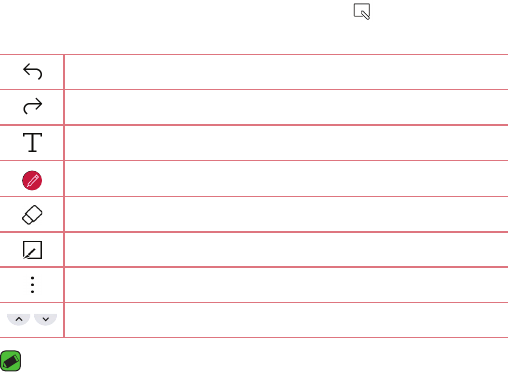
Features you will love 17
Capture+
The Capture+ feature allows you to create memos.
Using Capture+
You can use Capture+ function to easily and efficiently create memos
during a call, with a saved picture or on the current device screen.
1 Touch and slide the status bar downward and tap .
2 Create a memo using the following options:
Tap to undo the most recent action.
Tap to redo the most recently deleted action.
Tap to insert text into your memo.
Tap to select the pen type and color.
Tap to use the eraser to erase the pen marks on the memo.
Tap to crop the memo image.
Tap to share the memo or change the background paper style.
Tap to hide or display the toolbar.
NOTE
• While using Capture+, use your fingertip, not your fingernail.

Features you will love
18
3 Tap to save the current memo to the QuickMemo+ app or the
Gallery.
Viewing the saved memo
Tap > and select the Capture+ album.
OR
Tap > > and select the desired memo.

Features you will love 19
KnockON
The KnockON feature allows you to double-tap the screen to easily turn it
on or off.
Turning the screen on
1 Double-tap the center of the Lock screen to turn the screen on.
2 Unlock the screen or access any of the available shortcuts or widgets.
Turning the screen off
1 Double-tap an empty area of the Home screen or the Status Bar.
2 The screen will turn off.
NOTE
• For better recognition performance, tap on the center of the screen, but not on
the bottom or on the top of the screen.

Features you will love
20
Knock Code
The Knock Code feature allows you to create your own unlock code using
a combination of knocks on the screen. You can access the Home screen
directly when the screen is off by tapping the same sequence on the
screen.
NOTE
• If you enter the wrong Knock Code 6 times, you will be required to enter to
backup PIN.
• Use your fingertip instead of your fingernail to tap the screen to turn it on or
off.
Setting up the Knock Code feature
1 Tap > > Lock screen > Select screen lock > Knock Code.
2 Tap the squares in a pattern to set your Knock Code. Your Knock Code
pattern can be 6 to 8 taps.
Unlocking the screen using the Knock Code
When the screen turns off, you can unlock the screen by tapping the Knock
Code pattern you already set.

BasicsBasics

Basics
22
Accessories
These accessories are available for use with your device.
• Travel Adaptor
• Quick Start Guide
• USB Cable
• Battery
NOTE
• Items described above may be optional.
• Always use genuine LG accessories. The supplied items are designed only for this
device and may not be compatible with other devices.
• The items supplied with the device and any available accessories may vary
depending on the region or service provider.
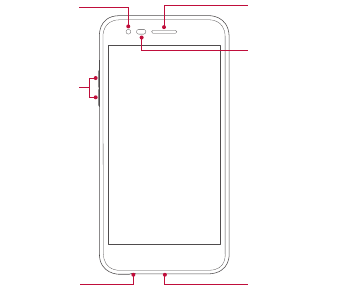
Basics 23
Device layout
Headset Jack
Earpiece
Charger/USB Port
Proximity/
Ambient
Light Sensor Front Camera Lens
Volume Keys
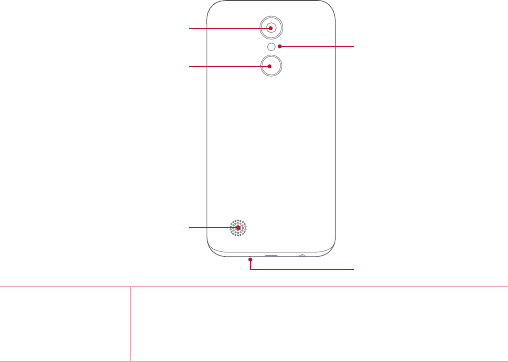
Basics
24
Speaker
Power/Lock Key
Microphone
Rear Camera Lens
Flash
Power/Lock Key • Turn your device on/off by pressing and holding
this key.
• Press once to turn the screen on/off.

Basics 25
Volume Keys While the screen is off:
• Press the Volume Up Key twice to launch
Capture+.
• Press the Volume Down Key twice to launch the
Camera.
On the Home screen:
• Control the ringer volume.
During a call:
• Control your earpiece volume.
When playing audio/video:
• Control the volume continuously.
NOTE: Proximity Sensor
• When receiving and making calls, the proximity sensor automatically turns the
backlight off and locks the touch screen by sensing when the phone is near your
ear. This extends battery life and prevents you from unintentionally activating
the touch screen during calls.
WARNING
• Placing a heavy object on the phone or sitting on it can damage the display and
touch screen functions.
• Do not cover the proximity sensor with screen protectors or any other type of
protective film. This could cause the sensor to malfunction.
Basics
26
Turning Your Device On and Off
Turning your device on
Press and hold the Power/Lock Key on the back of the device for a couple
of seconds until the screen turns on.
Turning your device off
1 Press and hold the Power/Lock Key on the back of the device until the
Device options menu appears.
2 Tap Power off in the Device options menu.
3 Tap POWER OFF to confirm that you want to turn off the device.
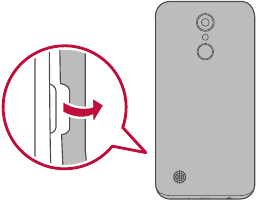
Basics 27
Installing the battery
Before you can start exploring your new device, you'll need to set it up.
1 To remove the back cover, hold the device firmly in one hand. With your
other hand, lift off the back cover with your thumbnail as shown in the
figure below.
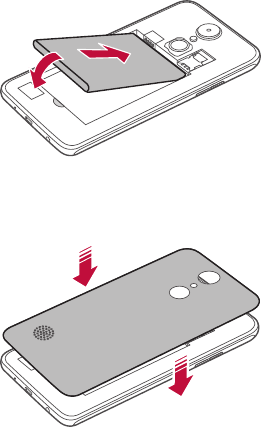
Basics
28
2 Insert the battery.
3 To replace the cover onto the device, align the back cover over the battery
compartment and press it down until it clicks into place.
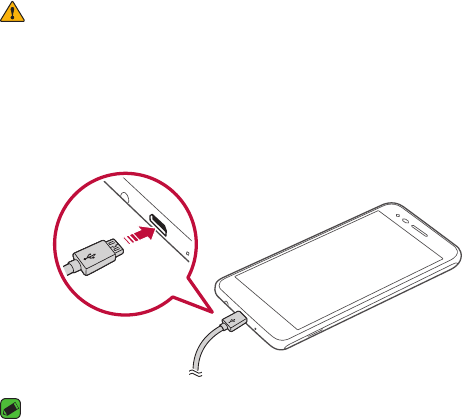
Basics 29
Charging the battery
Charge the battery before using it for first time. Use the charger that came
with your device to charge the battery. A computer can also be used to
charge the battery by connecting the device to it using the USB cable.
WARNING
• Use only LG-approved chargers, batteries and cables. The use of unapproved
chargers, batteries or cables may cause a battery charging delay. It can also
cause the battery to explode or damage the device, which are not covered by
the warranty.
The charger connector is located at the bottom of the device. Insert the
charger and plug it into a power outlet.
NOTE
• Do not open the back cover while your device is charging.
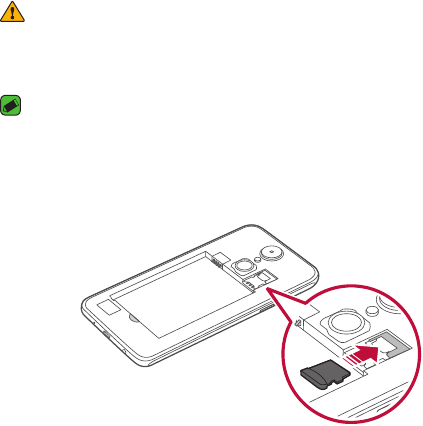
Basics
30
Inserting a memory card
Your device supports up to a 32 GB microSD card. Depending on the
memory card manufacturer and type, some memory cards may not be
compatible with your device.
WARNING
• Some memory cards may not be fully compatible with the device. If you use an
incompatible card, it may damage the device or the memory card, or corrupt the
data stored in it.
NOTE
• If you write and erase data too frequently, it will shorten the memory card
lifespan.
1 Remove the back cover.
2 Insert a memory card with the gold-colored contacts facing downwards.

Basics 31
3 Replace the back cover.
Removing the memory card
Before removing the memory card, first unmount it for safe removal.
1 Tap > > Storage & USB > .
2 Remove the back cover and pull out the memory card.
WARNING
• Do not remove the memory card while the device is transferring or accessing
information. This behavior can cause data to be lost or corrupted or can damage
the memory card or the device. LG is not responsible for losses that result from
the abuse or improper use of memory cards, including the loss of data.
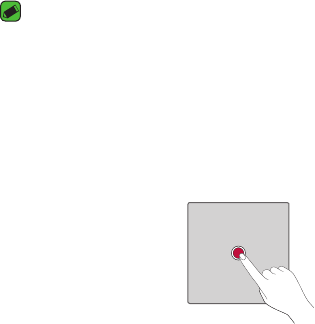
Basics
32
Touch screen tips
Here are some tips on how to navigate on your device.
NOTE
• Do not press too hard; the touch screen is sensitive enough to pick up a light,
yet firm tap.
• Use the tip of your finger to tap the option you want. Be careful not to tap any
other buttons.
Tap or touch
Tap or touch to activate your chosen item, link, shortcut, or letter on the
on-screen keyboard.
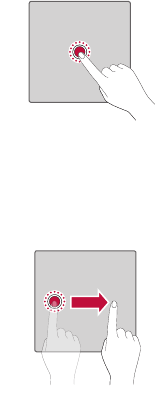
Basics 33
Touch and hold
Touch and hold an item on the screen by touching it and not lifting your
finger until an action occurs.
Drag
Touch and hold an item for a moment and then, without lifting your finger,
move your finger on the screen until you reach the target position. You can
drag items on the Home screen to reposition them.
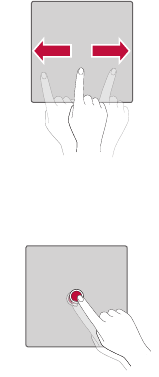
Basics
34
Swipe or slide
To swipe or slide, quickly move your finger across the surface of the screen,
without pausing when you first tap it (so you don't drag an item instead).
Double-tap
Double-tap to zoom on a webpage or a map.
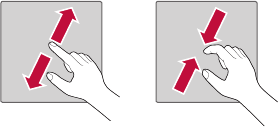
Basics 35
Pinch-to-Zoom
Use your index finger and thumb in a pinching or spreading motion to zoom
in or out when using the browser, Maps, or when viewing pictures.

Basics
36
Google account setup
The first time you open a Google application on your device, you will be
required to sign in with your existing Google account. If you do not have a
Google account, you will be prompted to create one.
Creating your Google account
1 Tap > > Accounts & sync.
2 Tap ADD ACCOUNT > Google > Or create a new account.
3 Enter your first and last name, then tap NEXT.
4 Enter a username and tap NEXT. Your device will communicate with
Google servers and check for username availability.
5 Enter your password and tap NEXT.
6 Follow the instructions and enter the required and optional information
about the account. Wait while the server creates your account.

Basics 37
Signing into your Google account
1 Tap > > Accounts & sync.
2 Tap ADD ACCOUNT > Google.
3 Enter your email address and tap NEXT.
4 Enter your password and tap NEXT.
5 After signing in, you can use Gmail and take advantage of Google
services on your device.
After signing in, your device will sync with your Google services, such as
Gmail, Contacts, and Google Calendar. You can also use Maps, download
applications from Play Store, back up your settings to Google servers, and
take advantage of other Google services on your device.

Basics
38
Locking and unlocking the device
Pressing the Power/Lock Key turns off the screen and puts the device
into lock mode. The device automatically gets locked if it is not used for a
specified period. This helps to prevent accidental taps and saves battery
power.
To unlock the device, press the Power/Lock Key and swipe the screen in any
direction.
Changing the screen lock method
You can change the way that you lock the screen to prevent others
accessing your personal information.
1 Tap > > Lock screen > Select screen lock.
2 Select a desired screen lock from None, Swipe, Knock Code, Pattern,
PIN and Password.
NOTE
• Remember the Backup PIN you created when creating your pattern lock.

Basics 39
Smart Lock
You can use Smart Lock to make unlocking your device easier. You can set
it to keep your device unlocked when you have a trusted Bluetooth® device
connected to it, when it's in a familiar location like your home or work, when
it recognizes your face or voice, or when it detects it's on your body.
Setting up Smart Lock feature
1 Tap > > Lock screen > Smart Lock.
2 Follow the instructions on the screen.
NOTE
• Before you add any trusted items or on-body detection, you need to set up a
screen lock (Knock Code, Pattern, PIN or Password).
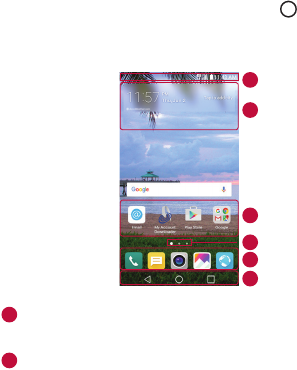
Basics
40
Home screen
The Home screen is the starting point for many applications and functions.
It allows you to add items like app shortcuts and Google widgets to give you
instant access to information and applications. This is the default canvas
and accessible from any menu by tapping .
Getting to Know the Home Screen
Status Bar
Widget
Application Icons
Location Indicator
Quick Button Area
Home Touch Buttons
1
2
3
4
5
6
1Status Bar - Shows the device's status information, including the time,
signal strength, battery status and notification icons.
2Widget - Widgets are self-contained applications that can be accessed
through the Home screen. Unlike a shortcut, the Widget can function as
an on-screen application.
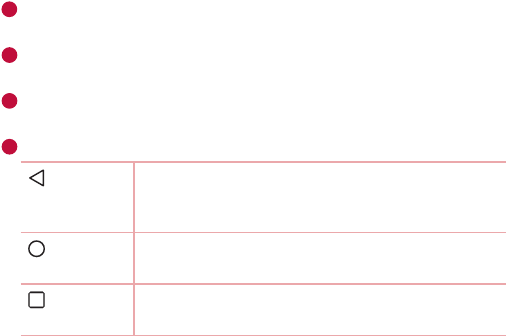
Basics 41
3
Application Icons - Tap an icon (application, folder, etc.) to open and
use it.
4Location Indicator - Indicates which Home screen canvas you are
currently viewing.
5Quick Button Area - Provides one-touch access to the function in any
Home screen canvas.
6Home Touch Buttons
Back
Button
Returns to the previous screen. Also closes pop-up
items, such as menus, dialog boxes and the on-screen
keyboard.
Home
Button
Return to the Home screen from any screen.
Touch and hold to access Google Now.
Overview
Button
Displays recently used applications. If you touch and
hold this button, it opens a menu of available options.
To view other Home screen panels
The operating system provides multiple Home screen canvases to provide
more space for adding icons, widgets and more.
• Slide your finger left or right across the Home screen to access
additional canvases.

Basics
42
Returning to recently-used applications
Multitasking is easy with Android; you can keep more than one application
running at the same time. There is no need to quit an application before
opening another. Use and switch between several open applications.
Android manages each application, stopping and starting them as needed
to make sure that idle applications don't consume resources unnecessarily.
1 Tap . A list of recently used applications will be displayed.
2 Tap the application you want to access. This does not stop the previous
app from running in the background. Make sure to tap to back out of an
app after using it.
• To close an app from the recent apps list, swipe the app preview to the
left or right. To clear all apps, tap Clear all.
Customizing the Home screen
You can customize your Home screen by adding widgets and changing
Home screen settings.
Editing the Home screen
On the Home screen, touch and hold on an empty space of the Home
screen.
• To rearrange the Home screen canvases, touch and hold on a canvas,
then drag it to another location.
• To add widgets to the Home screen, tap Widgets and drag a widget to
the Home screen.
Basics 43
• To change the Home screen settings, tap Home screen settings and
customize the desired options.
• To view a list of apps that have been uninstalled in the previous 24
hours, tap Uninstalled apps.
Moving apps on the Home screen
On the Home screen, touch and hold an app, then drag it to another
location.
• To keep frequently used apps at the bottom of the Home screen, touch
and hold an app, then drag it to the quick access area at the bottom.
• To remove an icon from the quick access area, drag the icon to the
Home screen.
Using folders from the Home screen
Creating folders
On the Home screen, touch and hold an app, then drag it over another app.
• A new folder is created and the app is added to the folder.
Editing folders
On the Home screen, tap a folder and then do one of the following:
• To edit the folder name and color, tap the folder name.
• To remove an app from the folder, touch and hold the app and drag it
to the outside the folder. If only one app is left in the folder, the folder
disappears automatically.
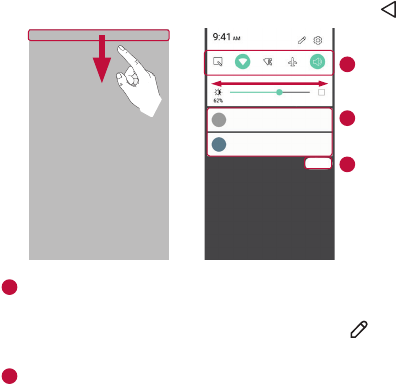
Basics
44
Notifications panel
Notifications alert you to the arrival of new messages, calendar events and
alarms, as well as ongoing events, such as when you are on a call.
Opening the notifications panel
Swipe down from the status bar to open the notifications panel. To close
the notifications panel, swipe the screen upwards or tap .
1
2
3
Quick Settings Area
Notifications
Clear
1Tap each quick setting button to toggle it on/off. Touch and hold the
desired button to directly access the settings menu for the function. To
see more toggle buttons, swipe left or right. Tap to remove, add or
rearrange the quick setting buttons.
2Current notifications are listed, each with a brief description. Tap a
notification to view it.
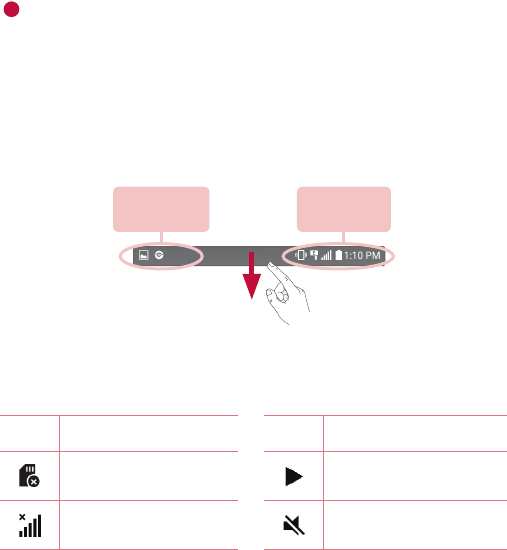
Basics 45
3Tap to clear all the notifications.
When a notification arrives, its icon appears at the top of the screen. Icons
for pending notifications appear on the left, and system icons, such as
Wi-Fi and battery strength are shown on the right.
Indicator icons on the Status Bar
Indicator icons appear on the status bar at the top of the screen to report
missed calls, new messages, calendar events, device status and more.
Pending
notifications
System
notifications
The icons displayed at the top of the screen provide information about the
status of the device. The icons listed in the table below are some of the
most common ones.
Icon Description Icon Description
No SIM card inserted A song is currently
playing
No network signal
available Ringer is silenced
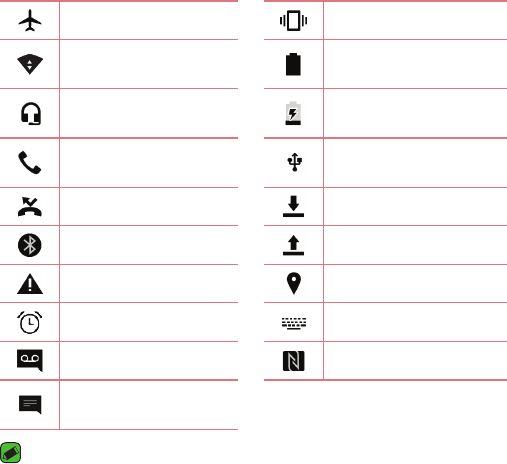
Basics
46
Airplane mode is on Vibrate mode is on
Connected to a Wi-Fi
network Battery fully charged
Wired headset (with
microphone) connected Battery is charging
Call in progress The phone is connected
to a PC via a USB cable
Missed call Downloading data
Bluetooth is on Uploading data
System warning GPS is on
An alarm is set Choose input method
New voicemail available NFC is on
New text or multimedia
message
NOTE
• The icon's location in the status bar may differ depending on the function or
service.
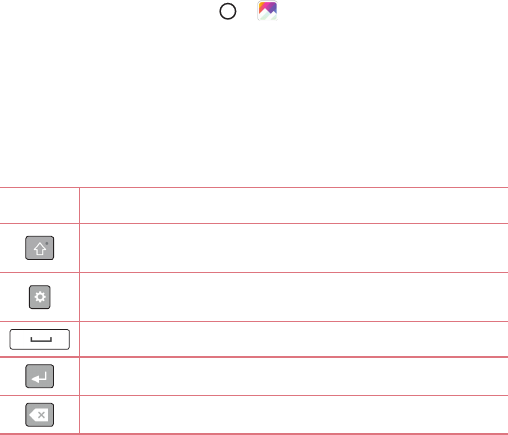
Basics 47
Capturing a screenshot
Press and hold the Volume Down Key and the Power/Lock Key at the
same time for 2 seconds to capture a screenshot of the current screen.
To view the captured image, tap > > the Screenshots folder.
On-screen keyboard
You can enter text by using the on-screen keyboard. The on-screen
keyboard appears on the screen when you tap an available text entry field.
Using the keypad and entering text
Icon Description
Tap once to capitalize the next letter you type. Double-tap for
all caps.
Tap to go to the keyboard settings. Touch and hold to enter
text by voice or access the clip tray.
Tap to enter a space.
Tap to create a new line.
Tap to delete the previous character.

Basics
48
Entering special characters
The on-screen keyboard allows you to enter special characters.
For example, to input "á", touch and hold the "a" button until the pop-up
appears and displays related special characters. Without lifting the finger,
drag your finger to the desired special character. Once it's highlighted, lift
your finger.
NOTE
• A symbol at the top right corner of a key indicates that additional characters are
available for that key.
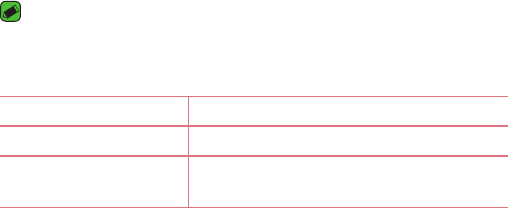
Basics 49
Transferring data between a PC and the
device
You can copy or move data between a PC and the device.
Transferring data using USB connection
1 Connect your device to a PC using the USB cable that came with your
device.
2 Open the Notifications panel, tap the current connection type, and select
File transfer.
3 A window will pop-up on your PC, allowing you to transfer the desired
data.
NOTE
• The LG Android Platform Driver is required to be installed on your PC to be able
to detect the device.
• Check the requirements for using File transfer.
Items Requirement
OS Microsoft Windows XP SP3, Vista or higher
Window Media Player
version Windows Media Player 10 or higher

AppsApps

Apps 51
Installing or uninstalling apps
Play Store allows you to browse and search for free and paid applications.
To open the Play Store app
Tap > .
To open a screen with details about an app
At any time while browsing in Play Store, tap an app to open its details
screen.
The App details screen includes a description, ratings, comments, and
related information about the app. From this screen, you can download,
install, uninstall, rate the app, and more.
To uninstall applications
1 Tap > > Apps.
2 Once all applications appear, scroll to and select the application you want
to uninstall.
3 Tap Uninstall.
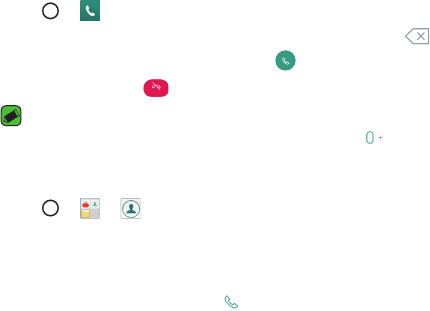
Apps
52
Calls
You can enjoy clear calling across the region.
Making a call
1 Tap > .
2 Enter the number by using the dialer. To delete a digit, tap .
3 After entering the desired number, tap to place the call.
4 To end the call, tap .
NOTE
• To enter "+" to make international calls, touch and hold .
Calling your contacts
1 Tap > > .
2 Scroll through the contact list. You can also enter the contact's name in
the Search field or scroll along the alphabet letters on the right edge of
the screen.
3 In the list that is displayed, tap next to the contact you want to call.
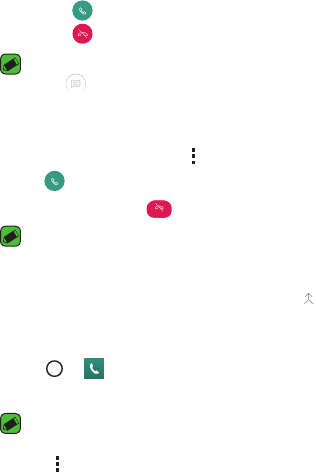
Apps 53
Answering and rejecting a call
• Swipe in any direction to answer an incoming call.
• Swipe in any direction to decline an incoming call.
NOTE
• Swipe if you want to decline a call and send a message to the caller.
Making a second call
1 During your first call, tap > Add call and enter the number.
2 Tap . Your initial call is locked and put on hold.
3 To end all calls, tap .
NOTE
• You may be charged for each call you make. Contact your service provider for
more information.
• To merge both calls into a conference call, tap .
Viewing your call logs
1 Tap > > Call logs tab.
2 A list of all dialed, received and missed calls is displayed.
NOTE
• Tap any call log entry to view the date, time and duration of the call.
• Tap > Delete all to delete all of the recorded items.

Apps
54
Change your call settings
You can configure device call settings, such as call forwarding, as well as
other special features offered by your carrier.
1 Tap > .
2 Tap > Call settings and configure the desired options.

Apps 55
Contacts
You can add contacts on your device and synchronize them with the
contacts in your Google Account or other accounts that support syncing
contacts.
Searching for a contact
1 Tap > > .
2 Tap Search contacts and enter the contact name using the keyboard.
Matches are displayed as you begin to type.
Adding a new contact
1 Tap > .
2 Enter the new contact's number.
3 Tap > Add to Contacts > Create contact.
4 If you want to add a picture to the new contact, tap the image icon.
Choose Take photo or Select photo.
5 Enter the desired information for the contact.
6 Tap SAVE.
Favorites contacts
You can classify frequently called contacts as favorites.

Apps
56
Adding a contact to your favorites
1 Tap > > .
2 Tap a contact to view its details.
3 Tap the star at the top right of the screen. The star will be highlighted.
Removing a contact from your favorites list
1 Tap > > and scroll to the FAVORITES section.
2 Choose a contact to view its details.
3 Tap the highlighted star at the top right of the screen. The highlight
will be removed from the star and the contact is removed from your
favorites.
Creating a group
1 Tap > > > Groups tab.
2 Tap > New group.
3 Enter a name for the new group. You can also set a distinct ringtone for
the newly created group.
4 Tap Add members to add contacts to the group and tap ADD.
5 Tap SAVE to save the group.
NOTE
• If you delete a group, the contacts assigned to that group will not be lost. They
will remain in your contact list.
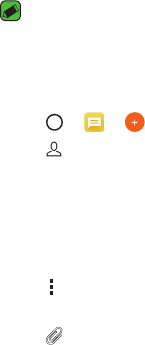
Apps 57
Messaging
Your device combines text and multimedia messaging into one intuitive,
easy to use menu.
NOTE
• You may be charged for each message you send. Please consult with your
service provider.
Sending a message
1 Tap > > .
2 Tap , then select one or more entries from your Contacts list.
OR
Enter a contact name or contact number into the To field. As you enter
the contact name, matching contacts appear. You can tap a suggested
recipient and add more than one contact.
3 Tap the text field and start entering your message.
4 Tap to open the options menu. Choose from any of the available
options.
5 Tap to attach the file that you want to share with message.
6 Tap Send to send your message.

Apps
58
Conversation view
Messages exchanged with another party are displayed in chronological
order so that you can conveniently see and find your conversations.
Changing your messaging settings
Your device's messaging settings are predefined to allow you to send
messages immediately. You can change the settings based on your
preferences.
• Tap > > > Settings.
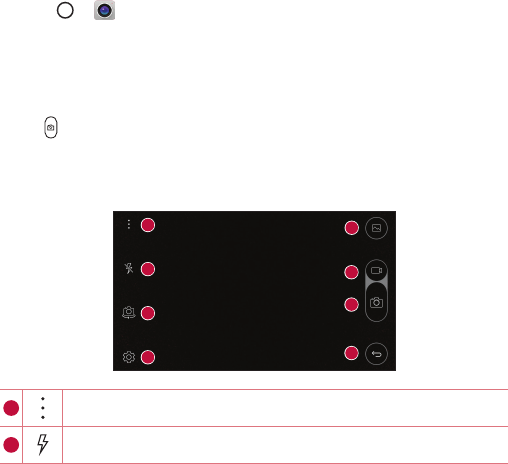
Apps 59
Camera
You can use the camera or camcorder to take and share pictures and
videos.
• Tap > .
Taking a photo
1 Frame your subject on the screen.
2 Green squares around the subject indicates that the camera has focused.
3 Tap to take a photo. Your picture will be automatically saved to the
Gallery.
Viewfinder options
15
8
26
7
3
4
1Tap to hide/display the camera options on the viewfinder.
2Tap to manage the camera's flash.
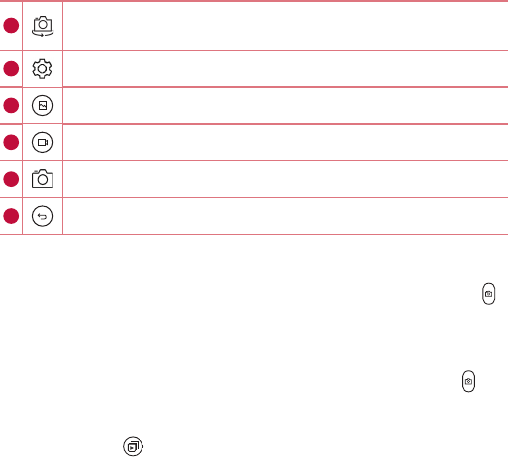
Apps
60
3Tap to swap between the rear camera lens and the front camera
lens.
4Tap to open the camera settings menu.
5Tap to view the last photo or video you recorded.
6Tap to start recording.
7Tap to take a photo.
8Tap to exit the camera.
Interval shot
You can take Interval shots using the front camera lens. Touch and hold
to automatically take 4 selfies in a row.
Burst shot
You can take Burst shots using the rear camera lens. Touch and hold to
take a barrage of photos in a row until the Capture button is released. The
viewfinder displays the number of shots taken. When viewing Burst shots
in the Gallery, tap to display each shot in sequence (similar to a viewing
flipbook).
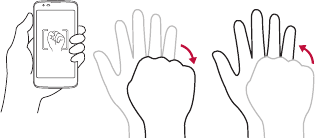
Apps 61
Gesture shot
The Gesture shot feature allows you to take a picture with a hand gesture
using the front camera.
Using a gesture to take photos
There are two methods for using the Gesture shot feature.
• Raise your hand, with an open palm, until the front camera detects it
and a box appears on the screen. Then close your hand into a fist to
start the timer, allowing you time to get ready.
OR
• Raise your hand, in a clenched fist, until the front camera detects it and
a box appears on the screen. Then unclench your fist to start the timer,
allowing you time to get ready.
OR
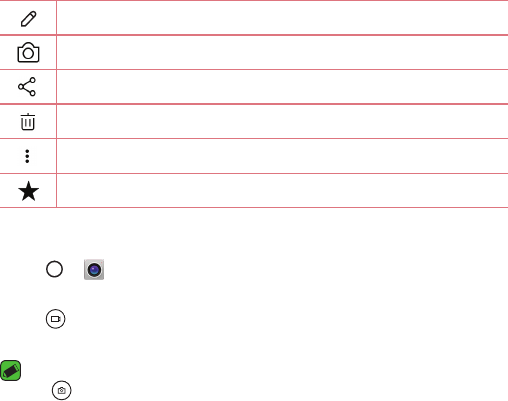
Apps
62
Multi-point Auto-focus
When you take a picture, the Multi-point Auto-focus (AF) function
operates automatically and will allow you to see a clear image.
Once you have taken a photo
Tap the image thumbnail on the screen to view the last photo you took.
Tap to edit the photo.
Tap to take another photo immediately.
Tap to share the photo.
Tap to delete the photo.
Tap to access additional options.
Tap to add the photo to your favorites.
Recording a video
1 Tap > .
2 Frame your subject on the screen.
3 Tap to start recording the video. The length of the recording is
displayed at the top of the screen.
NOTE
• Tap to take pictures while recording video.
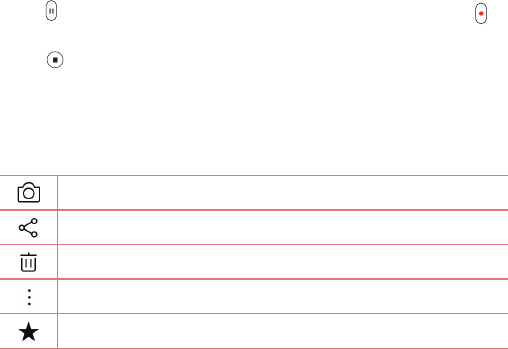
Apps 63
4 Tap to pause the recording. You can resume recording by tapping .
OR
Tap to stop recording. Your video will be automatically saved to the
Gallery.
After recording a video
Tap the video thumbnail on the screen to view the last video you recorded.
Tap to record another video immediately.
Tap to share the video.
Tap to delete the video.
Tap to access additional options.
Tap to add the video to your favorites

Apps
64
Gallery
The Gallery application presents the pictures and videos in your storage,
including those you've taken with the Camera application and those you
downloaded from the web or other locations.
1 Tap > .
2 Tap an album to open it and view its contents. (The pictures and videos
in the album are displayed in chronological order.)
3 Tap a picture in an album to view it.
NOTE
• Depending on the software installed, some file formats may not be supported.
• Some files may not play properly due to their encoding.
• If the file size exceeds the available memory, an error can occur when you open
files.
Viewing pictures
The Gallery displays your pictures in folders. When an application, such
as Email, saves a picture, a folder is automatically created to contain the
picture.
Pictures are displayed by the date they were created. Select a picture to
view it full screen. Scroll left or right to view the next or previous image.
Editing photos
While viewing a photo, tap .

Apps 65
Setting wallpaper
While viewing a photo, tap > More > Set image as to set the image as
wallpaper or assign it to a contact.
Zooming in and out
Use one of the following methods to zoom in on an image:
• Double-tap anywhere to zoom in and out.
• Spread two fingers apart on any place in the picture zoom in. Pinch in
to zoom out.
Playing a video
1 Tap > .
2 Select the video you want to watch.
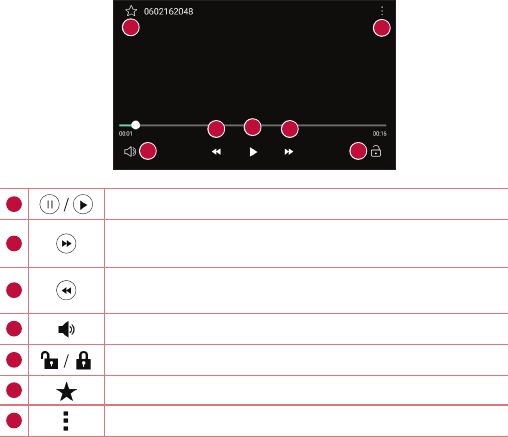
Apps
66
Video options
123
4 5
67
1 Tap to pause/resume video playback.
2Touch and hold to fast-forward in 3 second increments.
Tap to fast-forward 10 seconds.
3Touch and hold to rewind in 3 second increments. Tap to
rewind 10 seconds.
4Tap to adjust the video volume.
5 Tap to lock/unlock the screen.
6Tap to add the video to your favorites.
7Tap to access additional options.

Apps 67
NOTE
• While playing a video, slide the right side of the screen up or down to adjust the
sound.
• While playing a video, slide the left side of the screen up or down to adjust the
brightness.
• While playing a video, slide your finger from left to right (or vice versa) to fast-
forward and rewind.
Deleting photos/videos
Use one of the following methods:
• While in a folder, tap , select the photos/videos and then tap
DELETE.
• While viewing a photo, tap .

Apps
68
Email
You can use the Email application to read email from providers other than
Gmail.TheEmailapplicationsupportsthefollowingaccounttypes:POP3,
IMAP, Microsoft Exchange (for Enterprise users) and other accounts.
• Tap > .
Adding an account
The first time you open the Email application, a setup wizard opens to help
you add an email account. You can also add your email account using the
Settings menu.
• Tap > Settings > .
Working with account folders
• Tap > Show all folders.
Each account has Inbox, VIP, Sent, and Drafts. Depending on the features
supported by your account's service provider, you may have additional
folders.
Composing and sending email
1 Tap .
2 Enter an address for the message's intended recipient. As you enter text,
matching addresses will be offered from your contacts. Separate multiple
addresses with semicolons.

Apps 69
3 Tap the Cc/Bcc field to copy or blind copy other contacts/email
addresses.
4 Tap the text field and enter your message.
5 Touch and hold the text field to edit selected words. (Bold/Italic/
Underline/Text Color)
6 Tap to attach the file you want to send with your message.
7 Tap to send the message.
Changing the Email app general settings
• Tap > Settings > GENERAL.
Deleting an email account
• Tap > Settings > > Remove account > Select the account to
delete (if necessary) > REMOVE (if necessary) > REMOVE.

Apps
70
Music
Your device has a music player that lets you play all your favorite tracks.
NOTE
• Depending on the software installed, some file formats may not be supported.
• If the file size exceeds the available memory, an error can occur when you open
files.
• Music file copyrights may be protected by international treaties and national
copyright laws. Therefore, it may be necessary to obtain permission or a licence
to reproduce or copy music. In some countries, national laws prohibit private
copying of copyrighted material. Before downloading or copying the file, please
check the national laws of the relevant country concerning the use of such
material.
Playing a song
1 Tap > .
2 Select a music category tab at the top of the screen.
3 Tap the song you want to play.
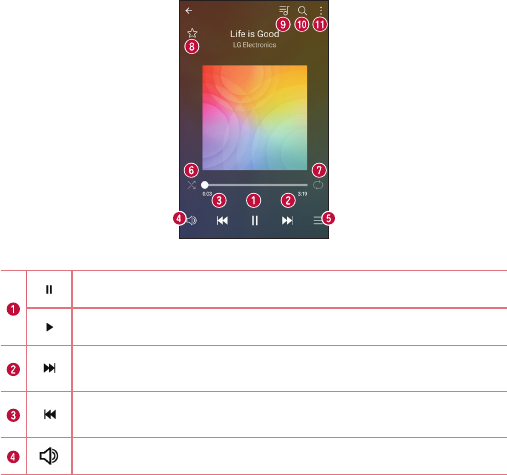
Apps 71
Music player options
Tap to pause playback.
Tap to resume playback.
Tap to skip to the next track in the album, playlist or shuffle list.
Touch and hold to fast-forward.
Tap to restart the current track or skip to the previous track in
the album, playlist or shuffle list. Touch and hold to rewind.
Tap to adjust the volume.
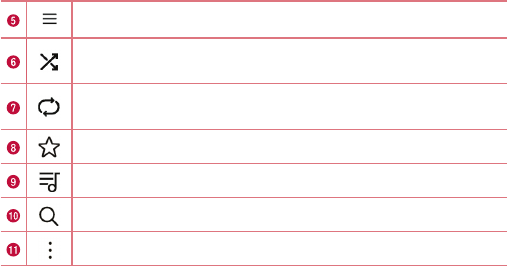
Apps
72
Tap to see the music library.
Tap to play the current playlist in shuffle mode (tracks are
played in random order).
Tap to toggle through repeat all songs, repeat current song and
repeat off.
Tap to add the song to your favorites.
Tap to open the current playlist.
Tap to search for music files.
Tap to access additional options.

Apps 73
Clock
The Clock app gives you access to the Alarms, Timer, World clock and
Stopwatch functions. Access these functions by tapping the tabs across
the top of the screen or swiping horizontally across the screen.
• Tap > > .
Alarms
The Alarm tab allows you to set alarms.
1 Tap the Alarm tab.
2 Tap to add a new alarm.
3 Adjust the settings as necessary and tap SAVE.
NOTE
• You can also tap an existing alarm to edit it.
World clock
The World clock tab allows you to easily check the current time in other
cities around the world.
1 Tap the World clock tab.
2 Tap and search for the desired city.
Apps
74
Timer
The Timer tab can alert you with an audible signal when a set amount of
time has passed.
1 Tap the Timer tab.
2 Set the desired time on the timer.
3 Tap Start to start the timer.
4 Tap Stop to stop the timer.
Stopwatch
The Stopwatch tab allows you to use your device as a stopwatch.
1 Tap the Stopwatch tab.
2 Tap Start to initiate the stopwatch.
• Tap Lap to record lap times.
3 Tap Stop to stop stopwatch.
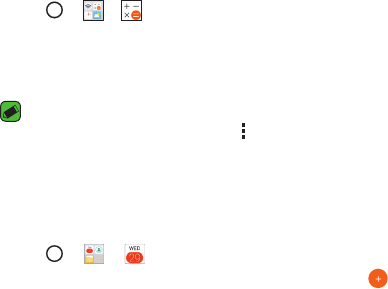
Apps 75
Calculator
The Calculator app allows you to perform mathematical calculations using a
standard or scientific calculator.
1 Tap > > .
2 Tap the number buttons to enter numbers.
3 For simple calculations, tap the function you want to perform (+, –, x or
÷) followed by =.
NOTE
• For more complex calculations, tap > Scientific calculator.
Calendar
The Calendar app allows you to track your schedule of events.
1 Tap > > .
2 Tap the date you want to add an event to. Then tap .
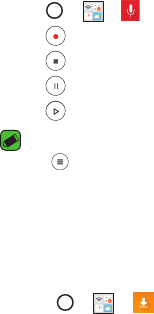
Apps
76
Voice Recorder
The Voice Recorder app records audible files for you to use in a variety of
ways.
Recording a sound or voice
1 Tap > > .
2 Tap to begin recording.
3 Tap to end the recording.
4 Tap to pause the recording.
5 Tap to listen to the recording.
NOTE
• Tap to access your recordings. You can listen to your saved recordings.
Downloads
Use this application to see what files have been downloaded through the
applications.
• Tap > > .

Apps 77
Google apps
Google provides entertainment, social network, and business apps. You may
require a Google account to access some apps.
To view more app information, access each app’s help menu.
NOTE
• Some apps may not be available depending on the region or service provider.
Google
Search quickly for items on the Internet or your device.
Chrome
Search for information and browse webpages.
Gmail
Send or receive emails via the Google Mail service.
Maps
Find your location on the map, search for locations, and view location
information for various places.
YouTube
Watch or create videos and share them with others.
Apps
78
Drive
Store your content on the cloud, access it from anywhere, and share it with
others.
Play Music
Discover, listen to, and share music on your device.
Play Movies & TV
Watch movies and TV shows purchased from the Play Store.
Hangouts
Chat with your friends individually or in groups and use images, emoticons,
and video calls while you are chatting.
Photos
Manage photos, albums, and videos that you have saved on the device and
uploaded to Google+.

SettingsSettings

Settings
80
Access the Settings menu
The Settings app allows you to customize and personalize your device.
Opening the settings app
• Tap > touch and hold > System settings.
OR
• Tap > .

Settings 81
Wireless Networks
Airplane mode
Allows you to use many of your device's features, such as games, and
music, when you are in an area where making or receiving calls or data use
is prohibited. When you set your device to Airplane Mode, it cannot send or
receive any calls or access online data.
On the Settings screen, tap Airplane mode.
Wi-Fi
You can use high-speed Internet access while within the coverage of the
wireless access point (AP).
On the Settings screen, tap Wi-Fi.
1 Tap to turn Wi-Fi on and start scanning for available Wi-Fi
networks.
2 Tap a network to connect to it.
• If the network is secured with a lock icon, you will need to enter a
security key or password.
• The status bar displays icons that indicate Wi-Fi status.
NOTE
• If you are out of the Wi-Fi zone or have set Wi-Fi to Off, the device may
automatically connect to the Web using mobile data, which may incur data
charges.

Settings
82
Bluetooth
Bluetooth is a short-range communications technology that allows you to
connect wirelessly to a number of Bluetooth devices, such as headsets and
hands-free car kits, and Bluetooth-enabled handhelds, computers, printers,
and wireless devices.
NOTE
• LG is not responsible for the loss, interception or misuse of data sent or received
via the Bluetooth feature.
• Always make sure that you share and receive data with devices that are trusted
and properly secured.
• If there are obstacles between the devices, the operating distance may be
reduced.
• Some devices, especially those that are not tested or approved by Bluetooth SIG,
may be incompatible with your device.
Pairing your device with another Bluetooth device
1 On the Settings screen, tap Bluetooth.
2 Tap to turn Bluetooth on and start scanning for available Bluetooth
devices.
• If you want to detect the visible devices in range additionally, tap
SEARCH.
3 Choose the device you want to pair with from the list. Once the paring is
successful, your device connects to the other device.

Settings 83
NOTE
• Pairing between two Bluetooth devices is a one-time process. Once a pairing
has been created, the devices will continue to recognize their partnership and
exchange information.
• Please consult documentation included with Bluetooth device for information on
pairing mode and passcode (typically 0 0 0 0 – four zeroes).
Sending data via Bluetooth
1 Select a file or item, such as a contact or media file.
2 Select the option for sending data via Bluetooth.
3 Search for and pair with a Bluetooth-enabled device.
NOTE
• Due to different specifications and features of other Bluetooth-compatible
devices, display and operations may be different, and functions such as transfer
or exchange may not be possible with all Bluetooth compatible devices.
Receiving data via Bluetooth
1 On the Settings screen, tap Bluetooth.
2 Tap to turn Bluetooth on.
3 You will receive data from the sending device. Be sure to select ACCEPT.

Settings
84
Mobile data
Displays the data usage and mobile data usage limit.
1 On the Settings screen, tap Mobile data.
2 Tap to toggle your mobile data connection On or Off. This allows
you to manage your mobile data usage. You can use a Wi-Fi network
connection for data instead.
Call
You can customise call settings, such as voice call and international call
options.
On the Settings screen, tap Call.
NOTE
• Some features may not be supported, depending on the device manufacturer or
service provider.
Advanced Calling
You can turn on or off HD Voice.
On the Settings screen, tap Advanced Calling.
NOTE
• HD Voice may not be supported depending on the area or service provider.

Settings 85
Tethering
USB tethering
You can connect the device to another device via USB and share mobile
data.
1 Connect your device and other devices via USB cable.
2 On the settings screen, tap Tethering > USB tethering and then drag
to activate it.
NOTE
• This option uses mobile data and may incur data usage fees, depending on your
pricing plan. Consult with your service provider for more information.
• When connecting to a computer, download the USB driver from www.lg.com and
install it on the computer.
• You cannot send or receive files between your device and a computer while USB
tethering is turned on. Turn off USB tethering to send or receive files.
• Operating systems that support tethering are Window XP or higher, or Linux.
Wi-Fi Hotspot
You can set the device as a wireless router so that other devices can
connect to the Internet by using your device's mobile data.
1 On the settings screen, tap Tethering >Wi-Fi Hotspot and then drag
to activate it.
2 Tap Set up Wi-Fi Hotspot and enter the Wi-Fi ID (SSID) and password.
3 Turn on Wi-Fi on the other device, and select the name of the device
network on the Wi-Fi list.

Settings
86
4 Enter the network password.
NOTE
• This option uses mobile data and may incur data usage fees, depending on your
pricing plan. Consult with your service provider for more information.
• More information is available at this web site:
http://www.android.com/tether#wifi
Bluetooth tethering
A Bluetooth-connected device can connect to the Internet by using your
device's mobile data.
1 On the settings screen, tap Tethering > Bluetooth tethering and then
drag to activate it.
2 Turn on Bluetooth on both devices, and pair them.
NOTE
• This option uses mobile data and may incur data usage fees, depending on your
pricing plan. Consult with your service provider for more information.
• More information is available at this web site:
http://www.android.com/tether#Bluetooth_tethering
Help
You can view help on using tethering and hotspots.
On the settings screen, tap Tethering > Help.
Settings 87
Mobile networks
This menu allows you to configure various mobile network settings such as
Mobile data, Data roaming, etc.
On the Settings screen, tap More > Mobile networks.
VPN
From your device, you can add, set up, and manage virtual private networks
(VPNs) that allow you to connect and access resources inside a secured
local network, such as your corporate network.
On the Settings screen, tap More > VPN.
Emergency alerts
If emergency alerts are issued, those alerts will appear on this menu.
On the Settings screen, tap More > Emergency alerts.
Printing
Allows you to print the content of certain screens (such as web pages
displayed in Chrome) to a printer connected to the same Wi-Fi network as
your Android device.
On the Settings screen, tap More > Printing.
Settings
88
Device
Sound & notification
Allows you to change settings for various sounds on the device.
On the Settings screen, tap Sound & notification.
• Sound profile – Allows you to set your device's sound profile.
• Volume – Adjust the device's volume settings to suit your needs and
environment.
• Ringtone – Allows you to set the ringtones for calls. You can also add
and delete ringtones.
• Ringtone ID – Allows you to compose ringtones based on the incoming
call's phone number.
• Sound with vibration –
Enable to set the device to vibrate in addition to
the ringtone when you receive calls.
• Vibration type – Allows you to choose the type of vibration.
• Do not disturb – Allows you to set a schedule when to prevent
interruptions from notifications. You can set to allow certain features to
interrupt when Priority only is set.
• Lock screen – Allows you to choose if you want to show or hide
notifications on the lock screen.
• Apps – Allows you to set notifications for individual apps including
preventing them from displaying notifications and setting priority.
• Notification sound – Allows you to set the notification sound. You can
also add and delete notification sounds.
Settings 89
• Vibrate on tap – Enable to vibrate when tapping the Home touch
buttons and during other UI interactions.
• Sound effects – This menu lets you select whether you hear tones
when tapping numbers on the dial pad, selecting on-screen options,
when locking and unlocking the screen, and the emergency tone
behavior.
• Message/call voice notifications – Allows your device to read out
incoming calls and message events automatically.
Display
Allows you to set other display settings.
On the Settings screen, tap Display.
• Font type – Select the desired font type.
• Font size – Select the desired font size.
• Bold text – Bold the text on the screen.
• Brightness – Adjust the screen brightness by using the slider.
• Reader mode – Set the device to reduce amount of blue light on screen
to reduce eye strain.
• Auto-rotate screen – Set to switch orientation automatically when you
rotate the device.
• Screen timeout – Set the time delay before the screen automatically
turns off.
• Home touch button combination – Set the Home touch buttons
displayed at the bottom of all screens.
Settings
90
• Daydream – Select the screen saver to be displayed when the device is
sleeping while docked and/or charging.
• Motion sensor calibration – Allows you to improve the accuracy of the
tilt and speed of the sensor.
Home screen
Allows you to set your home screen settings.
On the Settings screen, tap Home screen.
• Select Home – Select the desired Home theme.
• Wallpaper – Sets the wallpaper to use on your Home screen.
• Screen swipe effect – Choose the desired type of effect to display
when you swipe from one Home screen canvas to the next.
• Sort apps by – Sort apps by names or download date on the Home
screen.
• Grid – Change the app arrangement mode for the Home screen.
• Hide apps – Select the apps you want to hide from the Home screen.
Lock screen
Allows you to set your lock screen settings.
On the Settings screen, tap Lock screen.
• Select screen lock – Allows you to set a screen lock type to secure
your device.
• Smart Lock – Sets to keep your device unlocked with trusted device
or a place. If you need more information, please refer to Smart Lock
section in Locking and unlocking the device.
Settings 91
• Screen swipe effect – Sets the effect used when swiping the lock
screen.
• Wallpaper – Select the wallpaper to display for your lock screen.
• Shortcuts – Allows you to choose the shortcuts available on the lock
screen.
• Contact info for lost phone – Allows you to display the owner
information on the lock screen in case the device is lost.
• Lock timer – Allows you to set the amount of time before the screen
automatically locks after the screen has timed-out.
• Power key instantly locks – Enable to instantly lock the screen when
the Power/Lock Key is pressed. This setting overrides the lock timer
setting.
Storage & USB
You can monitor the used and available memory in the device.
On the Settings screen, tap Storage & USB.
Battery & power saving
Displays the current battery status including the percentage of remaining
charge and charging state.
On the Settings screen, tap Battery & power saving.
• Battery usage – Displays the battery usage level and battery use
details. Tap one of the items to see more detailed information.
• Battery percentage on status bar – Enable to display the battery level
percentage on the Status Bar next to the Battery icon.
Settings
92
• Battery saver – Tap the Battery Saver switch to toggle it on or off. Sets
the battery charge percent level that automatically turns on Battery
Saver.
• Help – Displays help information for the Battery saver feature.
Memory
You can monitor the memory used on average and the memory used by
apps in the device.
On the Settings screen, tap Memory.
Apps
Allows you to view details about the apps installed on your device, manage
their data, and force them to stop.
On the Settings screen, tap Apps.
Personal
Location
Turn on location service, your device determines your approximate location
using Wi-Fi and mobile networks. When you select this option, you're
asked whether you consent to allowing Google to use your location when
providing these services.
Settings 93
On the Settings screen, tap Location.
• Mode – Sets the how your current location information is determined.
• RECENT LOCATION REQUEST – Displays apps that have recently
requested location information.
• Low power location estimation – Estimate the device location by
using low power consumption.
• Camera – Enable to tag photos or videos with their locations.
• Google Location History – Allows you to choose your location
information settings as accessed by Google and its products.
Security
Use this menu to configure how to help secure your device and its data.
On the Settings screen, tap Security.
• Content lock – Select lock types to lock memos for QuickMemo+.
• Encrypt phone – Allows you to encrypt data on the device for security.
You will be required to enter a PIN or password to decrypt your device
each time you power it on.
• Encrypt SD card – Encrypt SD card storage and keep data unavailable
for other devices.
• Set up SIM card lock – Sets the PIN to lock your SIM card and allows
you to change the PIN.
• Password typing visible – Enable to briefly show each character of
passwords as you enter them so that you can see what you enter.
• Phone administrators – View or deactivate device administrators.
Settings
94
• Unknown sources – Allow installation of non-Play Store applications.
• Verify apps – Disallow or warn before installation of apps that may
cause harm.
• Credential protection – Displays the current credential protection type.
• Certificate management – Allows you to manage your security
certificates.
• Trust agents – Select apps to use without unlocking screen.
• Screen pin – Allows you to pin a screen to keep the current screen in
view until you unpin it.
• Usage access for apps – Allows you to view usage information of apps
on your device.
Accounts & sync
Use this menu to add, remove, and manage your Google and other
supported accounts. You also use these settings to control how and
whether all applications send, receive, and sync data on their own schedules
and whether all applications can synchronize user data automatically.
On the Settings screen, tap Account & sync.
Gmail™, Calendar, and other applications may also have their own
settings to control how they synchronize data; see the sections on those
applications for details.
• Auto-sync data – Enable this option to automatically sync all accounts
you’ve added on your device.
• ACCOUNTS – Displays all of your added accounts. Tap one to view and/
or manage it.
Settings 95
• ADD ACCOUNT – Tap to add new account.
Language & keyboard
Allows you to change the text input settings.
On the Settings screen, tap Language & keyboard.
Select the language for the text on your device and for the on-screen
keyboard.
• Language – Choose a language to use on your device.
• Current keyboard – Allows you to select the keyboard you want to use
currently.
• LG Keyboard – Tap to change the LG Keyboard settings.
• Google voice typing – Tap to change the voice input settings.
• Text-to-speech output – Tap to set the preferred engine or general
settings for text-to-speech output.
• Pointer speed – Adjust the pointer speed.
• Reverse buttons – Reverse the mouse buttons to use the primary
button on the right.
Backup & reset
Change the settings for managing your settings and data.
On the Settings screen, tap Backup & reset.
• Back up my data – Back up app data, Wi-Fi passwords, and other
settings to Google servers.
• Backup account – Displays the account that is currently being used to
back up information.
Settings
96
• Automatic restore – When reinstalling an app, restore backed up
settings and data.
• Network settings reset – Reset all network settings.
• Factory data reset – Reset your settings to the factory default
values and delete all your data. If you reset the device this way, you are
prompted to re-enter the same information as when you first started
Android.
Google services
Use this menu to manage your Google apps and account settings.
On the Settings screen, tap Google services.
System
Shortcut keys
Get quick access to apps by pressing the Volume Keys twice when the
screen is off or locked.
On the Settings screen, tap Shortcut keys.
• Press the Volume Up Key twice when the screen is off or locked to
open the Capture+ app.
• Press the Volume Down Key twice when the screen is off or locked to
open the Camera app.
Settings 97
Date & time
Set your preferences for how the date and time is displayed.
On the Settings screen, tap Date & time.
Accessibility
Use the Accessibility settings to configure accessibility plug-ins you have
installed on your device.
On the Settings screen, tap Accessibility.
• Vision – Sets options for people with impaired sight.
- TalkBack – Allows you to set up the TalkBack function which assists
people with impaired vision by providing verbal feedback.
- Message/call voice notifications – Enable to allows you to hear
automatic spoken alerts for incoming calls and messages.
- Font size – Sets the font size.
- Bold text – Bold the text on the screen.
- Touch zoom – Allows you to zoom in and out by triple-tapping the
screen.
- Screen color inversion – Enable to invert the color of the screen and
content.
- Screen color adjustment – Allows you to adjust the color of screen
and content.
- Grayscale – Switch the screen to grayscale mode.
- End calls with the Power key – Enable so that you can end voice
calls by pressing the Power/Lock Key.
Settings
98
• Hearing – Sets options for people with impaired hearing.
- Captions – Allows you to customize caption settings for those with
hearing impairments.
- Flash alerts – Enable to set the flash to blink for incoming calls and
notifications.
- Turn off all sounds – Enable to turn off all device sounds.
- Audio type – Sets the audio type.
- Sound balance – Sets the audio route. Move the slider on the slide
bar to set it.
• Motor & cognition – Sets options for people with impaired motor
skills.
- Touch assistant – Show a touch board with easy access to common
actions.
- Touch and hold delay – Adjust the touch input time.
- Touch and hold for calls – Answer or decline calls by tapping and
holding the call button instead of dragging it.
- Screen timeout – Sets the amount of time before the backlight
turns off automatically.
- Touch control areas – Allows you to select an area of the screen to
limit touch activation to just that area of the screen.
• Accessibility features shortcut – Allow you to access selected
features quickly when triple-tapping the Home button.
• Auto-rotate screen – Enable to allow the device to rotate the screen
depending on the physical device orientation (portrait or landscape).
Settings 99
• Switch Access – Allows you to interact with your device using one or
more switches that work like keyboard keys. This menu can be helpful
for users with mobility limitations that prevent them from interacting
directly with the your device.
About phone
View legal information, check device status and software versions, and
perform a software update.
On the Settings screen, tap About phone.

AppendixAppendix

Appendix 101
Device software update
LG Mobile Device software update via Over-the-Air (OTA)
This feature allows you to conveniently update your device's software
to a newer version via OTA, without connecting using a USB data cable.
This feature will only be available if and when LG makes a newer firmware
version available for your device.
You should first check the software version on your mobile device: Settings
> About phone > Update Center > Software Update > Update now.
NOTE
• Your personal data from internal device storage—including information about
your Google account and any other accounts, your system/application data and
settings, any downloaded applications and your DRM licence—might be lost in
the process of updating your device's software. Therefore, LG recommends that
you backup your personal data before updating your device's software. LG does
not take responsibility for any loss of personal data.
• This feature depends on your network service provider, region and country.

Appendix
102
FAQ
This chapter lists some problems you might encounter when using your
device. Some problems require you to call your service provider, but most
are easy to fix yourself.
Message Possible causes Possible corrective measures
SIM card
error
There is no SIM card
in the device or it is
inserted incorrectly.
Make sure that the SIM card is
correctly inserted.
No network
connection/
Dropped
network
Signal is weak or
you are outside the
carrier network.
Move toward a window or into an
open area. Check the network operator
coverage map.
Operator applied
new services.
Check whether the SIM card is more
than 6~12 months old. If so, change
your SIM or USIM card at your network
provider's nearest branch. Contact your
service provider.
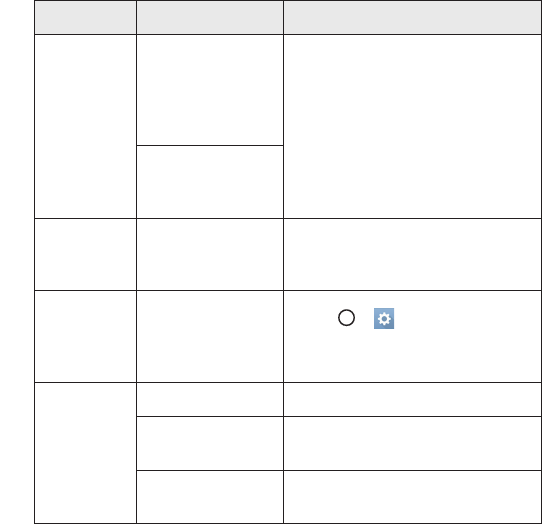
Appendix 103
Message Possible causes Possible corrective measures
Codes do
not match
To change a security
code, must need
to confirm the new
code by re-entering
it. If you forget the code, contact your
service provider.
The two codes you
entered do not
match.
No
applications
can be set
Not supported by
service provider or
registration required.
Contact your service provider.
Downloaded
application
causes a lot
of errors.
Remove the
application.
1 Tap > .
2 Tap Apps.
3 Tap the app > Uninstall.
Calls not
available
Dialing error New network not authorized.
New SIM card
inserted. Check for new restrictions.
Pre-paid charge limit
reached.
Contact service provider or reset limit
with PIN2.
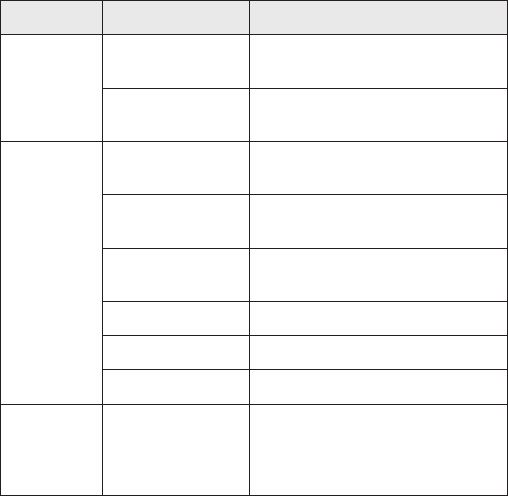
Appendix
104
Message Possible causes Possible corrective measures
Device
cannot be
turned on
On/Off key pressed
too briefly.
Press the On/Off key for at least two
seconds.
Battery is not
charged.
Charge battery. Check the charging
indicator on the display.
Charging
error
Battery is not
charged. Charge battery.
Outside temperature
is too hot or cold.
Make sure device is charging at a
normal temperature.
Contact problem Check the charger and its connection
to the device.
No voltage Plug the charger into a different outlet.
Charger defective Replace the charger.
Wrong charger Use only original LG accessories.
Impossible
to receive/
send SMS &
photos
Memory full
Delete some data, such as applications
or messages from your device to make
more memory available.

Appendix 105
Message Possible causes Possible corrective measures
Files do not
open
Unsupported file
format Check the supported file formats.
No sound Vibration mode
Check the settings status in the sound
menu to make sure you are not in
vibration or no interruptions mode.
Hangs up or
freezes
Intermittent
software problem
If the screen freezes or the device does
not respond when you try to operate
it, remove the battery and reinsert it.
Then power the device back on.
OR
Try to perform a software update
through the website.

Appendix
106
Anti-Theft Guide
You can set up your device to prevent other people from using it if it's been
reset to factory settings without your permission. For example, if your
device is lost, stolen, or wiped, only someone with your Google account or
screen lock information can use the device.
All you need to make sure your device is protected is:
• Set a screen lock: If your device is lost or stolen but you have a screen
lock set, the device can't be erased using the Settings menu unless
your screen is unlocked.
• Add your Google account on your device: If your device is wiped but
you have your Google account on it, the device can't finish the setup
process until your Google account information is entered again.
After your device is protected, you'll need to either unlock your screen or
enter your Google account password if you need to do a factory reset. This
ensures that you or someone you trust is doing the reset.
NOTE
• Do not forget your Google account and password you had added to your device
prior to performing a factory reset. If you can't provide the account information
during the setup process, you won't be able to use the device at all after
performing the factory reset.

Appendix 107
More information
Open Source Software Notice Information
To obtain the source code under GPL, LGPL, MPL, and other open source
licenses, that is contained in this product, please visit
http://opensource. lge.com.
In addition to the source code, all referred license terms, warranty
disclaimers and copyright notices are available for download.
LG Electronics will also provide open source code to you on CD-ROM for
a charge covering the cost of performing such distribution (such as the
cost of media, shipping, and handling) upon email request to opensource@
lge.com. This offer is valid for three (3) years from the date on which you
purchased the product.
Trademarks
• Copyright ©2016 LG Electronics, Inc. All rights reserved. LG and the LG
logo are registered trademarks of LG Group and its related entities.
• Google™, Google Maps™, Gmail™, YouTube™, Hangouts™ and Play
Store™ are trademarks of Google, Inc.
• Bluetooth is a registered trademark of Bluetooth SIG, Inc. worldwide.
• Wi-Fi and the Wi-Fi logo are registered trademarks of the Wi-Fi
Alliance.
• All other trademarks and copyrights are the property of their
respective owners.

For Your SafetyFor Your Safety
For Your Safety 109
HAC statement
This phone has been tested and rated for use with hearing aids for some of
the wireless technologies that it uses. However, there may be some newer
wireless technologies used in this phone that have not been tested yet for
use with hearing aids. It is important to try the different features of this
phone thoroughly and in different locations, using your hearing aid or cochlear
implant, to determine if you hear any interfering noise. Consult your service
provider or the manufacturer of this phone for information on hearing aid
compatibility. If you have questions about return or exchange policies, consult
your service provider or phone retailer. This mobile phone has a Hearing Aid
Mode that, when activated, may reduce interference with some hearing aid
models.
FCC RF Exposure Information
WARNING! Read this information before operating the phone.
In August 1996, the Federal Communications Commission (FCC) of the
United States, with its action in Report and Order FCC 96-326, adopted
an updated safety standard for human exposure to Radio Frequency (RF)
electromagnetic energy emitted by FCC regulated transmitters. Those
guidelines are consistent with the safety standard previously set by both U.S.
and international standards bodies. The design of this phone complies with
the FCC guidelines and these international standards.
For Your Safety 110
Body-worn Operation
This device was tested for typical use with the back of the phone kept 0.39
inches (1.0 cm) from the body. To comply with FCC RF exposure requirements,
a minimum separation distance of 0.39 inches (1.0 cm) must be maintained
between the user’s body and the back of the phone.
Any belt-clips, holsters, and similar accessories containing metallic
components may not be used. Avoid the use of accessories that cannot
maintain 0.39 inches (1.0 cm) distance between the user’s body and the back
of the phone and have not been tested for compliance with FCC RF exposure
limits.
Consumer Information About Radio Frequency
Emissions
Your wireless phone, which contains a radio transmitter and receiver,
emits radio frequency energy during use. The following consumer
information addresses commonly asked questions about the health
effects of wireless phones.
Are wireless phones safe?
Scientific research on the subject of wireless phones and radio frequency
(“RF”) energy has been conducted worldwide for many years, and continues.
In the United States, the Food and Drug Administration (“FDA”) and the
Federal Communications Commission (“FCC”) set policies and procedures
for wireless phones. The FDA issued a website publication on health issues
related to cell phone usage where it states, “The scientific community at large
… believes that the weight of scientific evidence does not show an association
between exposure to radiofrequency (RF) from cell phones and adverse
health outcomes. Still the scientific community does recommend conducting
additional research to address gaps in knowledge. That research is being
conducted around the world and FDA continues to monitor developments in
this field. You can access the joint FDA/FCC website at
http://www.fda.gov
(under “c”in the subject index, select Cell Phones > Research). You can also
contact the FDA toll-free at (888) 463-6332 or (888) INFO-FDA.
For Your Safety 111
In June 2000, the FDA entered into a cooperative research and development
agreement through which additional scientific research is being conducted.
The FCC issued its own website publication stating that “there is no scientific
evidence that proves that wireless phone usage can lead to cancer or a variety
of other problems, including headaches, dizziness or memory loss.” This
publication is available at
http://www.fcc.gov/cgb/cellular.html
or through the
FCC at (888) 225-5322 or (888) CALL-FCC.
What does “SAR” mean?
In 1996, the FCC, working with the FDA, the U.S. Environmental Protection
Agency, and other agencies, established RF exposure safety guidelines for
wireless phones in the United States. Before a wireless phone model is
available for sale to the public, it must be tested by the manufacturer and
certified to the FCC that it does not exceed limits established by the FCC. One
of these limits is expressed as a Specific Absorption Rate, or “SAR.” SAR is a
measure of the rate of absorption of RF energy in the body. Tests for SAR are
conducted with the phone transmitting at its highest power level in all tested
frequency bands. Since 1996, the FCC has required that the SAR of handheld
wireless phones not exceed 1.6 watts per kilogram, averaged over one gram
of tissue. Although the SAR is determined at the highest power level, the
actual SAR value of a wireless phone while operating can be less than the
reported SAR value. This is because the SAR value may vary from call to call,
depending on factors such as proximity to a cell site, the proximity of the
phone to the body while in use, and the use of hands-free devices.
For Your Safety 112
Can I minimize my RF exposure?
If you are concerned about RF, there are several simple steps you can take to
minimize your RF exposure. You can, of course, reduce your talk time.
You can place more distance between your body and the source of the RF, as
the exposure level drops off dramatically with distance. The FDA/FCC website
states that “hands-free kits can be used with wireless phones for convenience
and comfort. These systems reduce the absorption of RF energy in the head
because the phone, which is the source of the RF emissions, will not be placed
against the head. On the other hand, if the phone is mounted against the
waist or other part of the body during use, then that part of the body will
absorb more RF energy. Wireless phones marketed in the U.S. are required to
meet safety requirements regardless of whether they are used against the
head or against the body. Either configuration should result in compliance with
the safety limit.” Also, if you use your wireless phone while in a car, you can
use a phone with an antenna on the outside of the vehicle. You should also
read and follow your wireless phone manufacturer’s instructions for the safe
operation of your phone.
Do wireless phones pose any special risks to children?
The FDA/FCC website states that “the scientific evidence does not show a
danger to users of wireless communication devices, including children.” The
FDA/FCC website further states that “some groups sponsored by other
national governments have advised that children be discouraged from
using wireless phones at all”. For example, the Stewart Report from the
United Kingdom [“UK”] made such a recommendation in December 2000.
In this report a group of independent experts noted that no evidence exists
that using a cell phone causes brain tumors or other ill effects. [The UK’s]
recommendation to limit cell phone use by children was strictly precautionary;
it was not based on scientific evidence that any health hazard exists. A copy of
the UK’s leaflet is available at
http://www.dh.gov.uk
(search “mobile”), or you
can write to: NRPB, Chilton, Didcot, Oxon OX11 ORQ, United Kingdom. Copies
of the UK’s annual reports on mobile phones and RF are available online at
www.iegmp.org.uk
and
http://www.hpa.org.uk/radiation/
(search “mobile”).
Parents who wish to reduce their children’s RF exposure may choose to
restrict their children’s wireless phone use.
For Your Safety 113
Where can I get further information about RF emissions?
For further information, see the following additional resources (websites
current as of April 2005):
U.S. Food and Drug Administration
FDA Consumer magazine
November-December 2000
Telephone: (888) INFO-FDA
http://www.fda.gov
(Under “c” in the subject index, select Cell Phones >
Research.)
U.S. Federal Communications Commission
445 12th Street, S.W.
Washington, D.C. 20554
Telephone: (888) 225-5322
http://www.fcc.gov/oet/rfsafety
Independent Expert Group on Mobile Phones
http://www.iegmp.org.uk
Royal Society of Canada Expert Panels on Potential Health Risks of Radio
Frequency Fields from Wireless Telecommunication Devices
283 Sparks Street
Ottawa, Ontario K1R 7X9
Canada
Telephone: (613) 991-6990
http://www.rsc.ca/index.php?page=Expert_Panels_RF&Lang_id=120
World Health Organization
Avenue Appia 20
1211 Geneva 27
Switzerland
Telephone: 011 41 22 791 21 11
http://www.who.int/mediacenter/factsheets/fs193/en/
For Your Safety 114
International Commission on Non-Ionizing Radiation Protection
c/o Bundesamt fur Strahlenschutz
Ingolstaedter Landstr. 1
85764 Oberschleissheim
Germany
Telephone: 011 49 1888 333 2156
http://www.icnirp.de
American National Standards Institute
1819 L Street, N.W., 6th Floor
Washington, D.C. 20036
Telephone: (202) 293-8020
http://www.ansi.org
National Council on Radiation Protection and Measurements
7910 Woodmont Avenue, Suite 800
Bethesda, MD 20814-3095
Telephone: (301) 657-2652
http://www.ncrponline.org
Engineering in Medicine and Biology Society, Committee on Man and
Radiation (COMAR) of the Institute of Electrical and Electronics Engineers
http://ewh.ieee.org/soc/embs/comar/
Consumer Information on SAR
(Specific Absorption Rate)
This model phone meets the government’s requirements for exposure to radio
waves. Your wireless phone is a radio transmitter and receiver. It is designed
and manufactured not to exceed the emission limits for exposure to Radio
Frequency (RF) energy set by the Federal Communications Commission
of the U.S. Government. These limits are part of comprehensive guidelines
and establish permitted levels of RF energy for the general population. The
guidelines are based on standards that were developed by independent
scientific organizations through periodic and thorough evaluation of scientific
For Your Safety 115
studies. The standards include a substantial safety margin designed to assure
the safety of all persons, regardless of age and health.
The exposure standard for wireless mobile phones employs a unit of
measurement known as the Specific Absorption Rate, or SAR. The SAR limit
set by the FCC is 1.6 W/kg. Tests for SAR are conducted using standard
operating positions specified by the FCC with the phone transmitting at its
highest certified power level in all tested frequency bands. Although SAR is
determined at the highest certified power level, the actual SAR level of the
phone while operating can be well below the maximum value. Because the
phone is designed to operate at multiple power levels to use only the power
required to reach the network, in general, the closer you are to a wireless
base station antenna, the lower the power output. Before a phone model
is available for sale to the public, it must be tested and certified to the FCC
that it does not exceed the limit established by the government-adopted
requirement for safe exposure. The tests are performed in positions and
locations (e.g., at the ear and worn on the body) as required by the FCC for
each model.
(Body measurements differ among phone models, depending upon available
accessories and FCC requirements).
While there may be differences between SAR levels of various phones and
at various positions, they all meet the government requirement for safe
exposure.
The FCC has granted an Equipment Authorization for this model phone with
all reported SAR levels evaluated as in compliance with the FCC RF emission
guidelines. SAR information on this model phone is on file with the FCC and
can be found under the Display Grant section of
http://www.fcc.gov/oet/fccid
after searching on FCC ID ZNFL58VL. Additional information on Specific
Absorption Rates (SAR) can be found on the Cellular Telecommunications
Industry Association (CTIA) website at
http://www.ctia.org/
.
* In the United States and Canada, the SAR limit for mobile phones used
by the public is 1.6 watts/kg (W/kg) averaged over one gram of tissue.
The standard incorporates a substantial margin of safety to give additional
protection for the public and to account for any variations in measurements.
For Your Safety 116
FCC Hearing-Aid Compatibility (HAC)
Regulations for Wireless Devices
On July 10, 2003, the U.S. Federal Communications Commission (FCC) Report
and Order in WT Docket 01-309 modified the exception of wireless phones
under the Hearing Aid Compatibility Act of 1988 (HAC Act) to require digital
wireless phones be compatible with hearingaids. The intent of the HAC Act
is to ensure reasonable access to telecommunications services for persons
with hearing disabilities. While some wireless phones are used near some
hearing devices (hearing aids and cochlear implants), users may detect a
buzzing, humming, or whining noise. Some hearing devices are more immune
than others to this interference noise, and phones also vary in the amount of
interference they generate.
The wireless telephone industry has developed a rating system for wireless
phones, to assist hearing device users to find phones that may be compatible
with their hearing devices. Not all phones have been rated. Phones that are
rated have the rating on their box or a label located on the box.
The ratings are not guarantees. Results will vary depending on the user’s
hearing device and hearing loss. If your hearing device happens to be
vulnerable to interference, you may not be able to use a rated phone
successfully. Trying out the phone with your hearing device is the best way to
evaluate it for your personal needs.
M-Ratings: Phones rated M3 or M4 meet FCC requirements and are likely
to generate less interference to hearing devices than phones that are not
labeled. M4 is the better/higher of the two ratings. T-Ratings: Phones rated T3
or T4 meet FCC requirements and are likely to generate less interference to
hearing devices than phones that are not labeled. T4 is the better/ higher of
the two ratings.
Hearing devices may also be rated. Your hearing device manufacturer or
hearing health professional may help you find this rating. Higher ratings mean
that the hearing device is relatively immune to interference noise. The hearing
aid and wireless phone rating values are then added together.

For Your Safety 117
A sum of 5 is considered acceptable for normal use. A sum of 6 is considered
for best use.
In the above example, if a hearing aid meets the M2 level rating
and the wireless phone meets the M3 level rating, the sum of the
two values equal M5. This should provide the hearing aid user with
“normal usage” while using their hearing aid with the particular
wireless phone. “Normal usage” in this context is defined as a signal
quality that’s acceptable for normal operation.
The M mark is intended to be synonymous with the U mark. The T mark
is intended to be synonymous with the UT mark. The M and T marks are
recommended by the Alliance for Telecommunications Industries Solutions
(ATIS). The U and UT marks are referenced in Section 20.19 of the FCC Rules.
The HAC rating and measurement procedure are described in the American
National Standards Institute (ANSI) C63.19 standard.
To ensure that the Hearing Aid Compatibility rating for your phone
is maintained, secondary transmitters such as Bluetooth and WLAN
components must be disabled during a call.
For information about hearing aids and digital wireless phones
Wireless Phones and Hearing Aid Accessibility
http://www.accesswireless.org/
Gallaudet University, RERC
http://tap.gallaudet.edu/Voice/
FCC Hearing Aid Compatibility and Volume Control
http://www.fcc.gov/cgb/dro/hearing.html
The Hearing Aid Compatibility FCC Order
http://hraunfoss.fcc.gov/edocs_public/attachmatch/FCC-03-168A1.pdf
Hearing Loss Association of America [HLAA]
http://hearingloss.org/content/telephones-and-mobile-devices
For Your Safety 118
Caution:
Avoid potential hearing loss.
Prolonged exposure to loud sounds (including music) is the most common
cause of preventable hearing loss. Some scientific research suggests that
using portable audio devices, such as portable music players and cellular
telephones, at high volume settings for long durations may lead to permanent
noise-induced hearing loss. This includes the use of headphones (including
headsets, earbuds and Bluetooth or other wireless devices). Exposure to
very loud sound has also been associated in some studies with tinnitus (a
ringing in the ear), hypersensitivity to sound and distorted hearing. Individual
susceptibility to noise-induced hearing loss and other potential hearing
problems varies.
The amount of sound produced by a portable audio device varies depending
on the nature of the sound, the device, the device settings and the
headphones. You should follow some commonsense recommendations when
using any portable audio device:
Ţ Set the volume in a quiet environment and select the lowest volume at
which you can hear adequately.
Ţ When using headphones, turn the volume down if you cannot hear the
people speaking near you or if the person sitting next to you can hear what
you are listening to.
Ţ Do not turn the volume up to block out noisy surroundings. If you choose
to listen to your portable device in a noisy environment, use noise-
canceling headphones to block out background environmental noise.
Ţ Limit the amount of time you listen. As the volume increases, less time is
required before your hearing could be affected.
Ţ Avoid using headphones after exposure to extremely loud noises, such as
rock concerts, that might cause temporary hearing loss. Temporary hearing
loss might cause unsafe volumes to sound normal.
Ţ Do not listen at any volume that causes you discomfort. If you experience
ringing in your ears, hear muffled speech or experience any temporary
hearing difficulty after listening to your portable audio device, discontinue
use and consult your doctor.
For Your Safety 119
TIA Safety Information
The following is the complete TIA Safety Information for wireless handheld
phones.
Exposure to Radio Frequency Signal
Your wireless handheld portable phone is a low power radio transmitter and
receiver. When ON, it receives and sends out Radio Frequency (RF) signals.
In August, 1996, the Federal Communications Commissions (FCC) adopted
RF exposure guidelines with safety levels for handheld wireless phones. Those
guidelines are consistent with the safety standards previously set by both U.S.
and international standards bodies:
ANSI C95.1 (1992) *
NCRP Report 86 (1986)
ICNIRP (1996)
* American National Standards Institute; National Council on Radiation
Protection and Measurements; International Commission on Non-Ionizing
Radiation Protection.
Those standards were based on comprehensive and periodic evaluations of
the relevant scientific literature. For example, over 120 scientists, engineers,
and physicians from universities, government health agencies, and industry
reviewed the available body of research to develop the ANSI Standard (C95.1).
The design of your phone complies with the FCC guidelines (and those
standards).
Tips on Efficient Operation
For your phone to operate most efficiently:
Don’t touch the antenna unnecessarily when the phone is in use. Contact
with the antenna affects call quality and may cause the phone to operate at a
higher power level than otherwise needed.
Electronic Devices
Most modern electronic equipment is shielded from RF signals. However,
certain electronic equipment may not be shielded against the RF signals from
your wireless phone.
For Your Safety 120
Pacemakers
The Health Industry Manufacturers Association recommends that a minimum
separation of six (6) inches be maintained between a handheld wireless
phone and a pacemaker to avoid potential interference with the pacemaker.
These recommendations are consistent with the independent research by and
recommendations of Wireless Technology Research.
Persons with pacemakers:
Ţ Should ALWAYS keep the phone more than six (6) inches from their
pacemaker when the phone is turned ON;
Ţ Should not carry the phone in a breast pocket;
Ţ Should use the ear opposite the pacemaker to minimize the potential for
interference;
Ţ Should turn the phone OFF immediately if there is any reason to suspect
that interference is taking place.
Hearing Aids
Some digital wireless phones may interfere with some hearing aids. In the
event of such interference, you may want to consult your service provider (or
call the customer service line to discuss alternatives).
Other Medical Devices
If you use any other personal medical device, consult the manufacturer of your
device to determine if it is adequately shielded from external RF energy. Your
physician may be able to assist you in obtaining this information.
Health Care Facilities
Turn your phone OFF in health care facilities when any regulations posted in
these areas instruct you to do so. Hospitals or health care facilities may use
equipment that could be sensitive to external RF energy.
Vehicles
RF signals may affect improperly installed or inadequately shielded electronic
systems in motor vehicles. Check with the manufacturer or its representative
regarding your vehicle. You should also consult the manufacturer of any
equipment that has been added to your vehicle.
For Your Safety 121
Posted Facilities
Turn your phone OFF in any facility where posted notices so require.
Aircraft
FCC regulations prohibit using your phone while in the air. Switch OFF your
phone before boarding an aircraft.
Blasting Areas
To avoid interfering with blasting operations, turn your phone OFF when in a
“blasting area” or in areas posted: “Turn off two-way radio”. Obey all signs and
instructions.
Potentially Explosive Atmosphere
Turn your phone OFF when in any area with a potentially explosive
atmosphere and obey all signs and instructions. Sparks in such areas could
cause an explosion or fire resulting in bodily injury or even death. Areas with
a potentially explosive atmosphere are often, but not always marked clearly.
Potential areas may include: fueling areas (such as gasoline stations); below
deck on boats; fuel or chemical transfer or storage facilities; vehicles using
liquefied petroleum gas (such as propane or butane); areas where the air
contains chemicals or particles (such as grain, dust, or metal powders); and
any other area where you would normally be advised to turn off your vehicle
engine.
For Vehicles Equipped with an Air Bag
An air bag inflates with great force. DO NOT place objects, including either
installed or portable wireless equipment, in the area over the air bag or in
the air bag deployment area. If in-vehicle wireless equipment is improperly
installed and the air bag inflates, serious injury could result.
Part 15.19 statement
This device complies with part 15 of the FCC rules. Operation is subject to the
following two conditions:
(1) This device may not cause harmful interference, and
(2) This device must accept any interference received, including interference
that may cause undesired operation.
For Your Safety 122
Part 15.21 statement
Changes or modifications that are not expressly approved by the
manufacturer for compliance could void the user’s authority to operate the
equipment.
Part 15.105 statement
This equipment has been tested and found to comply with the limits for a
class B digital device, pursuant to Part 15 of the FCC rules. These limits are
designed to provide reasonable protection against harmful interference in
a residential installation. This equipment generates, uses, and can radiate
radio frequency energy and, if not installed and used in accordance with
the instructions, may cause harmful interference to radio communications.
However, there is no guarantee that interference will not occur in a particular
installation. If this equipment does cause harmful interference to radio or
television reception, which can be determined by turning the equipment off
and on, the user is encouraged to try to correct the interference by one or
more of the following measures:
Ţ Reorient or relocate the receiving antenna.
Ţ Increase the separation between the equipment and receiver.
Ţ Connect the equipment into an outlet on a circuit different from that to
which the receiver is connected.
Ţ Consult the dealer or an experienced radio/TV technician for help.